River Interlinking: Environmental Disaster or Solution?
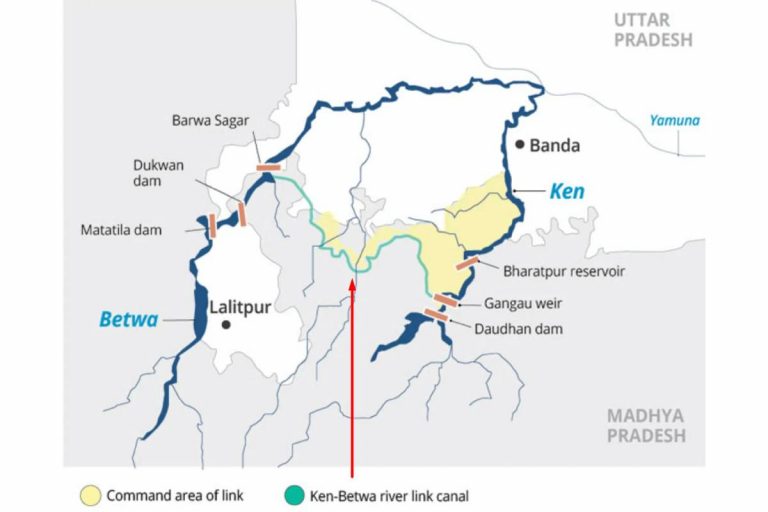
- 09 Jan 2025
Overview of the River Interlinking Concept
The concept of river interlinking in India traces its origins to the 19th century, when Sir Arthur Cotton first proposed inter-basin water transfer to address irrigation issues. Over time, this idea was refined by other experts. It evolved into the National Water Grid and, later, the River-Interlinking Project (ILR) under the Ministry of Water Resources. The goal is to transfer surplus water from rivers to drought-prone areas, aiming for water security, irrigation, and power generation.
Key Projects and Initiatives
- Ken-Betwa River Link Project (KBLP): Launched in December 2024, the KBLP will link the water-surplus Ken River with the drought-stricken Betwa River. It aims to irrigate over 10 lakh hectares, supply drinking water to 62 lakh people, and generate hydropower and solar power. However, concerns over the environmental impact of building a dam within the Panna Tiger Reserve have been raised.
- National River Linking Project (NRLP): The NRLP, formally known as the National Perspective Plan, is an ambitious proposal that includes 30 river links—14 Himalayan and 16 Peninsular—to connect India's rivers and create a giant South Asian Water Grid.
Benefits of Interlinking Rivers
- Flood and Drought Mitigation: Redistributing water from surplus areas to drought-prone regions, such as Bundelkhand, will reduce the severity of floods and droughts.
- Agriculture and Irrigation: Expanding irrigation systems across 35 million hectares of land could significantly boost agricultural productivity and food security.
- Hydropower Generation: The interlinking project has the potential to generate up to 34 GW of hydropower, contributing to India's renewable energy targets.
- Economic Growth: Improving water availability can boost industries, provide drinking water, and support economic development in underdeveloped regions.
- Inland Waterways: The project will also contribute to the expansion of inland waterways, benefiting trade and reducing transportation costs.
Challenges and Concerns
- Environmental Impact:
- Biodiversity Loss: Projects like the Ken-Betwa project raise alarms about the destruction of ecologically sensitive areas, such as the Panna Tiger Reserve.
- River Ecosystem Disruption: Altering natural river courses can harm aquatic life, disrupt deltaic ecosystems, and degrade water quality. For instance, the Sardar Sarovar Dam's impact on the Narmada river system shows the long-term consequences of such projects.
- Pollution: The mixing of cleaner and more polluted rivers could exacerbate water contamination issues.
- Social and Financial Costs:
- Displacement: Large-scale interlinking projects will displace millions, especially marginalized communities and indigenous people, and disturb local livelihoods.
- High Financial Burden: The total estimated cost of the NRLP is ?5.5 lakh crore, which does not include environmental rehabilitation costs or the long-term maintenance of the infrastructure.
- Climate Change: Predictions suggest that climate change could affect river flows and the availability of surplus water. This might render the interlinking project ineffective in the long term.
- Inter-State Conflicts: Water-sharing disputes, like the long-standing issues over the Cauvery and Krishna rivers, could intensify with more interlinking projects.
- Infrastructural Challenges: Maintaining vast canal networks and reservoirs, managing sedimentation, and acquiring land for construction are logistical hurdles.
Alternative Approaches and Solutions
- Efficient Water Management:
- Integrated Watershed Management: Implementing a comprehensive approach to manage existing water resources can reduce the need for large-scale river transfers.
- Groundwater Recharge: Focusing on efficient groundwater management by identifying recharge mechanisms and regulating water use is crucial for sustainability.
- Modern Irrigation Techniques:
- Drip Irrigation: Israel’s success with drip irrigation, which reduces water use by 25%-75%, provides an example of how modern technologies can save significant amounts of water.
- Virtual Water: Emphasizing the import of water-intensive goods (like wheat) could save local water resources, which would otherwise be used for domestic agriculture.
- National Waterways Project (NWP): An alternative to the interlinking project, NWP aims to improve water management by creating navigation channels that double as water distribution networks with a fraction of the land use.
Way Forward
- Comprehensive Impact Assessments: The need for multidisciplinary studies to evaluate the environmental, social, and economic impacts of river interlinking projects cannot be overstated. Stakeholder engagement is crucial for equitable decision-making.
- Sustainable Water Policies: A national water policy should prioritize sustainable water practices, focusing on local solutions, such as water harvesting, watershed management, and smart irrigation.
- Focus on Regional Solutions: Smaller, state-specific projects should be prioritized to address water scarcity issues without triggering large-scale environmental degradation.
The Impact of Climate Change on Earth’s Water Cycle
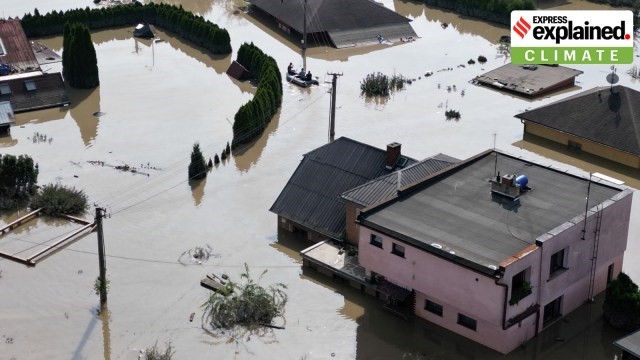
- 08 Jan 2025
In News:
Climate change is significantly affecting Earth's water cycle, leading to extreme weather events such as intense floods and prolonged droughts. According to the 2024 Global Water Monitor Report, this disruption is increasingly evident, as seen in the devastating weather patterns experienced worldwide in 2024. The report, based on data from international researchers, highlights how these changes are directly linked to rising global temperatures and the resulting shifts in precipitation patterns.
Understanding the Water Cycle
The water cycle is the continuous movement of water in various forms—solid, liquid, and gas—throughout the Earth's atmosphere, land, and bodies of water. This cycle involves processes such as:
- Evaporation: Water from the surface of oceans, lakes, and rivers turns into vapor.
- Transpiration: Water is absorbed by plants from the soil and released as vapor.
- Precipitation: Water vapor condenses into clouds and falls as rain or snow, replenishing the Earth's surface.
- Runoff and Infiltration: Precipitation either flows into rivers or infiltrates the soil, contributing to groundwater.
The water cycle is vital for maintaining the planet’s ecosystems, regulating weather patterns, and providing water for all living organisms. However, climate change is intensifying these natural processes, with far-reaching consequences.
Impact of Climate Change on the Water Cycle
As global temperatures rise, climate change is having a profound impact on the water cycle. Warmer temperatures lead to:
- Increased evaporation: As air temperatures soar, more water evaporates into the atmosphere. For every 1°C rise in temperature, the atmosphere can hold about 7% more moisture, which exacerbates storms and increases the intensity of rainfall.
- More intense precipitation: With more moisture in the atmosphere, storms have become more intense, leading to severe flooding in various regions.
- Increased droughts: Warmer air also dries out the soil. This reduces the amount of water available for crops and plants, while also increasing the evaporation rate from soil, leading to longer and more intense droughts.
This disruption of the water cycle is already causing erratic weather patterns, as some regions face severe droughts, while others are experiencing extreme rainfall and floods.
Key Findings from the 2024 Global Water Monitor Report
The 2024 report presents several alarming statistics that highlight the growing impact of climate change on the water cycle:
- Water-related disasters: In 2024, these disasters caused over 8,700 fatalities, displaced 40 million people, and resulted in economic losses exceeding $550 billion globally.
- Dry months: There were 38% more record-dry months in 2024 than the baseline period (1995-2005), underlining the growing frequency of droughts.
- Intense rainfall: Record-breaking rainfall occurred 27% more frequently in 2024 compared to 2000, with daily rainfall records set 52% more often. This shows the growing intensity of precipitation events.
- Terrestrial water storage (TWS): Many dry regions faced ongoing low TWS levels, reflecting the scarcity of water in these areas, while some regions, such as parts of Africa, saw an increase in water storage.
- Future predictions: Droughts may worsen in regions like northern South America, southern Africa, and parts of Asia, while areas like the Sahel and Europe could experience increased flood risks in the coming years.
Conclusion
The findings of the 2024 report underscore the alarming impact of climate change on the global water cycle. As temperatures continue to rise, we can expect more frequent and severe weather events, including extreme flooding and devastating droughts. These changes will affect billions of people worldwide, highlighting the urgent need for action to mitigate climate change and adapt to its consequences. Addressing this challenge requires global cooperation to reduce emissions, enhance water management systems, and protect vulnerable regions from the intensifying effects of climate change.
Surge in E-Waste Generation in India
- 29 Dec 2024
In News:
India has seen a significant increase in electronic waste (e-waste) generation, rising by 72.54% from 1.01 million metric tonnes (MT) in 2019-20 to 1.751 million MT in 2023-24. The sharpest rise occurred between 2019-20 and 2020-21, driven by increased electronic consumption due to the COVID-19 pandemic's work-from-home and remote learning arrangements.
Environmental and Health Concerns
E-waste contains hazardous substances like arsenic, cadmium, lead, and mercury. If not properly managed, these materials can severely impact human health and the environment, contaminating soil and water sources.
Government Efforts: E-Waste Management Rules, 2022
- Introduction of Extended Producer Responsibility (EPR): The government introduced the E-Waste (Management) Rules, 2022, effective from April 1, 2023. These rules focus on making producers responsible for the recycling of e-waste. Producers are assigned recycling targets based on the quantity of e-waste generated or products sold and must purchase EPR certificates from authorized recyclers to meet these targets.
- Integration of Bulk Consumers: Public institutions and government offices, categorized as bulk consumers, are mandated to dispose of e-waste only through registered recyclers or refurbishers, ensuring proper treatment and recycling of the waste.
- Expansion of E-Waste Coverage: The updated rules expanded the scope to include 106 Electrical and Electronic Equipment (EEE) items from FY 2023-24, up from 21 items previously covered under the 2016 E-Waste Rules.
Challenges in E-Waste Recycling and Disposal
- Low Recycling Rates: Although the share of e-waste recycled in India has increased from 22% in 2019-20 to 43% in 2023-24, a significant 57% of e-waste remains unprocessed annually. Informal sector practices, which dominate e-waste handling, often lack the necessary environmental safeguards, leading to improper disposal and environmental contamination.
- Lack of Infrastructure and Awareness: India faces challenges in building adequate infrastructure for e-waste collection and recycling, resulting in improper disposal in landfills. Furthermore, a lack of public awareness regarding proper disposal methods exacerbates the problem.
Global Context and India’s Position
- India ranks as the third-largest e-waste generator globally, following China and the United States. With an increasing rate of e-waste generation, the country faces an urgent need to improve recycling efficiency and adopt sustainable disposal methods.
International and National Conventions on E-Waste
- India is a signatory to several international conventions that govern hazardous waste management, including the Basel Convention, which regulates the transboundary movement of hazardous wastes, and the Minamata Convention, which focuses on mercury. At the national level, India has established the E-Waste (Management) Rules, 2022, and other frameworks to manage and reduce e-waste effectively.
Strategic Recommendations for Effective E-Waste Management
- Harnessing the Informal Sector: India’s informal sector, which handles a significant portion of e-waste, must be integrated into the formal recycling systems. This can be achieved through training and financial support to ensure safe and environmentally responsible recycling practices.
- Technological Innovations: Encouraging research into advanced recycling technologies, such as AI and IoT-based solutions for efficient e-waste collection and tracking, will be crucial for improving the e-waste management system.
- Learning from Global Practices: Countries like the European Union (EU) and Japan have set strong examples. The EU’s Waste Electrical and Electronic Equipment (WEEE) Directive and Japan’s Home Appliance Recycling Law emphasize Extended Producer Responsibility (EPR) and provide models for India to adapt.
Conclusion
To address the growing e-waste challenge, India must improve its recycling infrastructure, integrate the informal sector, and adopt best practices from international models. With sustainable and effective strategies, India can mitigate the environmental and health risks posed by e-waste while promoting a circular economy.
Supreme Court Directs Policy for Sacred Groves Protection

- 20 Dec 2024
In News:
Recently, the Supreme Court of India issued a significant judgment directing the Union Government to formulate a comprehensive policy for the protection and management of sacred groves across the country. These natural spaces, traditionally safeguarded by local communities, play a crucial role in preserving both ecological diversity and cultural heritage.
What are Sacred Groves?
Sacred Groves are patches of virgin forests that are protected by local communities due to their religious and cultural significance. They represent remnants of what were once dominant ecosystems and serve as key habitats for flora and fauna. Typically, sacred groves are not just ecological reserves, but also form an integral part of local traditions, often protected due to spiritual beliefs.
Key Features of Sacred Groves:
- Ecological Value: Sacred groves contribute significantly to biodiversity conservation.
- Cultural Significance: These groves are revered in various religious practices and are central to local traditions.
- Geographical Presence: Sacred groves are found in regions like Tamil Nadu, Kerala, Karnataka, Maharashtra, and parts of Rajasthan.
Supreme Court's Directive
The court's judgment was based on a plea highlighting the decline of sacred groves in Rajasthan, particularly those being lost due to deforestation and illegal land-use changes. While the Wildlife (Protection) Act of 1972 empowers state governments to declare community lands as reserves, the court recognized the need for a unified national policy to protect sacred groves as cultural reserves.
Recommendations:
- Nationwide Survey: The Ministry of Environment, Forest, and Climate Change (MoEF&CC) was instructed to conduct a nationwide survey to map and assess sacred groves, identifying their size and extent.
- Legal Protection: Sacred groves should be recognized as community reserves and protected under the Wildlife (Protection) Act, 1972.
- State-Specific Measures: The Rajasthan government was specifically directed to carry out detailed mapping (both on-ground and satellite) of sacred groves within the state, ensuring that the groves are recognized for their ecological and cultural significance.
The Role of Sacred Groves in Conservation
Sacred groves play a pivotal role in the conservation of biodiversity. They serve as refuges for various plant and animal species, and the traditional practices associated with these groves, such as tree worship, discourage destructive activities like logging and hunting.
Ecological and Cultural Importance:
- Sacred groves often act as critical biodiversity hotspots, preserving rare and indigenous species.
- They help maintain clean water ecosystems and act as carbon sinks, contributing to climate mitigation.
- Practices of non-interference with these areas have allowed flora and fauna to thrive over centuries.
Cultural Significance Across India
The importance of sacred groves is deeply embedded in India's diverse cultural heritage. They are considered the abode of deities, and various regions have unique names and rituals associated with these groves.
Examples of Sacred Groves in India:
- Himachal Pradesh: Devban
- Karnataka: Devarakadu
- Kerala: Kavu
- Rajasthan: Oran
- Maharashtra: Devrai
Piplantri Village Model
A key example highlighted in the judgment was the Piplantri village in Rajasthan, where the community undertook a remarkable transformation of barren land into flourishing groves. The initiative, driven by local leadership, involves planting 111 trees for every girl child born, which has led to several environmental and social benefits.
Impact of Piplantri's Community Efforts:
- Over 40 lakh trees have been planted, which has recharged the water table by 800-900 feet and lowered the local climate by 3-4°C.
- The initiative has contributed to the reduction of female foeticide and empowered women's self-help groups.
- The village now enjoys economic growth, better education opportunities, and increased local income.
Legal and Statutory Framework
Sacred groves are already recognized under existing Indian laws, notably the Wildlife (Protection) Act, 1972, which allows states to declare sacred groves as community reserves. Additionally, the National Forest Policy of 1988 encourages the involvement of local communities in the conservation of forest areas, a principle supported by the Godavarman Case of 1996.
Key Legal Provisions:
- Wildlife (Protection) Act, 1972: Empowers state governments to declare sacred groves as community reserves.
- National Forest Policy, 1988: Encourages community involvement in the conservation and protection of forests, including sacred groves.
- Scheduled Tribes and Other Traditional Forest Dwellers (Recognition of Forest Rights) Act, 2006: Suggests empowering traditional communities as custodians of sacred groves.
Looking Ahead: The Need for Action
The Supreme Court has scheduled further hearings to assess the progress of the survey and mapping efforts by Rajasthan. The court also stressed the importance of empowering traditional communities to continue their role as custodians of sacred groves, ensuring their sustainable protection for future generations.
By recognizing the ecological and cultural significance of sacred groves and encouraging community-driven conservation efforts, the Supreme Court’s ruling sets a precedent for more inclusive environmental policies in India. This could also inspire similar initiatives in other parts of the world, promoting the protection of sacred natural spaces for their critical role in maintaining biodiversity and fostering sustainable communities.
Arctic Tundra: From Carbon Sink to Carbon Source

- 18 Dec 2024
In News:
The Arctic tundra, a frozen, treeless biome, has historically been a vital carbon sink, absorbing vast amounts of carbon dioxide (CO?) and other greenhouse gases (GHGs). However, recent findings suggest that, for the first time in millennia, this ecosystem is emitting more carbon than it absorbs, a change that could have significant global consequences. This alarming shift was highlighted in the 2024 Arctic Report Card published by the National Oceanic and Atmospheric Administration (NOAA).
The Arctic Tundra’s Role as a Carbon Sink
The Arctic tundra plays a crucial role in regulating the Earth's climate. In typical ecosystems, plants absorb CO? through photosynthesis, and when they die, carbon is either consumed by decomposers or released back into the atmosphere. In contrast, the tundra’s cold environment significantly slows the decomposition process, trapping organic carbon in permafrost—the permanently frozen ground that underpins much of the region.
Over thousands of years, this accumulation of organic matter has resulted in the Arctic storing an estimated 1.6 trillion metric tonnes of carbon. This figure is roughly double the amount of carbon in the entire atmosphere. As such, the tundra has served as a critical carbon sink, helping to mitigate global warming by trapping vast quantities of CO?.
Shifting Dynamics: Emission of Greenhouse Gases
Recent reports indicate a dramatic shift in the Arctic tundra’s role in the carbon cycle. Rising temperatures and increasing wildfire activity have disrupted the tundra’s balance, leading it to transition from a carbon sink to a carbon source.
Impact of Rising Temperatures
The Arctic region is warming at a rate approximately four times faster than the global average. In 2024, Arctic surface air temperatures were recorded as the second-warmest on record since 1900. This rapid warming is causing permafrost to thaw, which in turn activates microbes that break down trapped organic material. As this decomposition accelerates, carbon in the form of CO? and methane (CH?)—a more potent greenhouse gas—are released into the atmosphere.
The experts, explained the process by comparing thawing permafrost to meat left out of the freezer. Similarly, thawing permafrost accelerates the breakdown of trapped carbon.
The Role of Wildfires
In addition to warming temperatures, the Arctic has experienced a surge in wildfires in recent years. 2024 marked the second-highest wildfire season on record in the region, releasing significant amounts of GHGs into the atmosphere. Wildfires exacerbate the thawing of permafrost, creating a feedback loop where increased carbon emissions contribute further to warming, which, in turn, leads to more emissions.
Between 2001 and 2020, these combined factors caused the Arctic tundra to release more carbon than it absorbed, likely for the first time in millennia.
The Global Consequences of Emission
The transition of the Arctic tundra from a carbon sink to a carbon source is alarming, as it represents a significant amplification of global climate change. The release of additional CO? and CH? into the atmosphere further accelerates the greenhouse effect, leading to higher global temperatures. This warming is already having visible consequences around the world, from extreme weather events to rising sea levels.
If the Arctic tundra continues to emit more carbon than it absorbs, it could significantly exacerbate the climate crisis. The report underscores the urgency of addressing global emissions, as reducing greenhouse gases remains the most effective way to prevent further destabilization of this sensitive ecosystem.
Mitigating the Impact: The Path Forward
Despite the alarming trends, the Arctic Report Card suggests that it is still possible to reverse this process. By reducing global GHG emissions, it may be possible to slow the thawing of permafrost and allow the Arctic tundra to regain its role as a carbon sink. Scientists emphasize that mitigating climate change on a global scale is essential to prevent further emissions from the Arctic ecosystem.
Scientists, stressed the importance of emission reductions, stating, “With lower levels of climate change, you get lower levels of emissions from permafrost… That should motivate us all to work towards more aggressive emissions reductions.”
However, current trends suggest that achieving this goal may be challenging. A recent report from the Global Carbon Project indicates that fossil fuel emissions are likely to rise in 2024, with total CO? emissions projected to reach 41.6 billion tonnes, up from 40.6 billion tonnes in 2023.
How would a carbon market function?

- 16 Dec 2024
In News:
COP29, the ongoing climate conference in Azerbaijan’s capital Baku, has given a fillip to the idea of using carbon markets to curb carbon emissions by approving standards that can help in the setting up of an international carbon market as soon as the coming year.
Introduction to Carbon Markets
- Carbon markets allow the buying and selling of the right to emit carbon dioxide (CO2) into the atmosphere.
- Governments issue certificates known as carbon credits, each representing the right to emit 1,000 kilograms of CO2.
- The total number of credits issued is capped to control carbon emissions. Companies and individuals who don’t have credits cannot emit CO2.
Trading of Carbon Credits
- Carbon Credit Trading: Companies holding more carbon credits than needed can sell them to others who need more, with the price determined by market forces.
- Carbon Offsets: Businesses can also purchase carbon offsets, often provided by environmental NGOs, which promise to reduce emissions (e.g., by planting trees). These offsets counterbalance the firm’s carbon emissions.
- The trading of both credits and offsets is designed to create financial incentives for companies to reduce their carbon footprint.
Advantages of Carbon Markets
- Addressing Externalities: Carbon emissions are a classic example of an economic externality, where the costs of pollution are not reflected in market prices.
- Market Efficiency: By allowing firms to buy and sell carbon credits, the system internalizes the cost of carbon emissions, encouraging businesses to reduce emissions to avoid higher costs.
- Incentive for Emission Reduction: Carbon markets aim to create a financial reason for companies to lower their emissions, thus helping mitigate climate change.
Voluntary vs. Government-Mandated Carbon Markets
- Voluntary Carbon Reporting: Many corporations prefer voluntary systems like the Carbon Disclosure Project (CDP) for reporting their emissions, fearing government-imposed restrictions.
- Market Flexibility: Corporations like ExxonMobil and General Motors argue that carbon markets with freely traded credits allocate carbon allowances more efficiently than government-imposed limits. This allows firms to purchase credits from others, optimizing resource allocation without restricting output.
- Corporate Resistance to Government Intervention: Firms are often reluctant to accept strict government budgets for carbon emissions, fearing increased operational costs and production limitations due to diverse supply chains.
Issues and Criticisms of Carbon Markets
- Government Manipulation of Credit Supply: Governments may increase the number of carbon credits issued, leading to lower prices and reduced incentives for emission reductions.
- Lack of Accountability in Carbon Offsets: Critics argue that some companies buy carbon offsets as a form of virtue signalling, without genuine concern for their environmental impact. This undermines the effectiveness of the offsets.
- Government Mismanagement: Political decision-making may lead to the over-restriction of carbon credits, potentially slowing economic growth by limiting available emissions allowances. The ability of governments to accurately determine the optimal supply of carbon credits is a contentious issue.
The Concept of Carbon Credits and Their History
- Introduction of Carbon Credits: Carbon credits were first introduced in the 1990s in the U.S., specifically through a cap-and-trade model designed to control sulfur dioxide emissions. This approach later expanded to include carbon emissions.
- Role of Carbon Markets: In essence, these markets aim to create a financial mechanism where firms can trade the right to pollute, ensuring a balance between economic growth and environmental protection.
Criticism of Carbon Offsets
- Effectiveness of Offsets: Experts are critical of carbon offsets, arguing that they do not always lead to meaningful reductions in emissions. For example, some companies may purchase offsets without ensuring that the projects are genuinely offsetting their emissions.
- Moral Hazard: Critics suggest that offset programs may lead to firms simply paying for the right to pollute, rather than actually reducing emissions in their operations.
Conclusion
- Carbon Markets as a Tool for Emission Reduction: Despite the criticisms, carbon markets remain a promising tool for mitigating climate change, provided they are carefully regulated and implemented.
- The Future of Carbon Trading: As discussions at COP29 evolve, the development of international standards for carbon trading could potentially enhance the effectiveness of these markets, offering a viable path to global emission reductions.
Reflections on Baku’s ‘NCQG Outcome’ at COP29
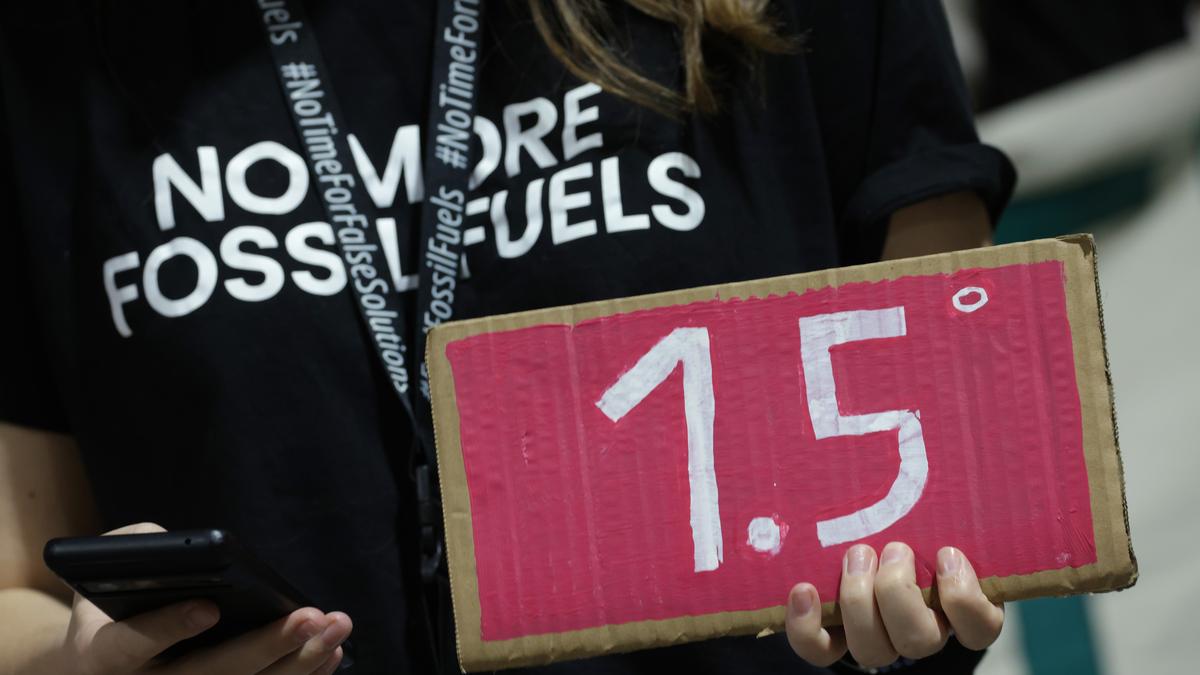
- 06 Dec 2024
In News:
The recently concluded COP29 in Baku, Azerbaijan, has brought the spotlight back to climate finance, particularly in relation to the New Collective Quantified Goal (NCQG). As the global community grapples with the escalating climate crisis, the discussions and outcomes from the COP29 summit are pivotal in shaping future climate action. However, the agreed-upon financial targets, which were expected to be a step towards transformative climate justice, have sparked significant concern, particularly among developing nations.
The Need for Climate Finance: A Global Responsibility
Climate finance is essential for supporting developing countries, which bear the brunt of climate change despite contributing minimally to global emissions. The Intergovernmental Panel on Climate Change (IPCC) has stressed the need to limit global warming to 1.5°C above pre-industrial levels, yet current policies could lead to a rise of up to 3.1°C. To counter this, developing nations require financial assistance to transition to green energy, adapt to climate impacts, and implement their Nationally Determined Contributions (NDCs).
The upfront costs of green technologies, such as renewable energy, are high, and while they offer long-term savings, their initial investments remain a significant barrier. Additionally, many developing countries face fiscal constraints, making it even more difficult to adopt climate-friendly technologies without external financial support.
The Role of NCQG in Addressing Climate Finance Gaps
The NCQG, an evolution of the 2010 $100 billion annual commitment, aims to provide clarity and accountability in climate financing. Established as a framework to ensure financial resources for climate action, the NCQG should ideally focus on the evolving needs of the Global South. However, at COP29, the target agreed upon was a mere $300 billion annually by 2035, far from the $1.3 trillion that developing countries had requested. This amount falls drastically short of what is necessary to meet the ambitious climate goals and fails to represent a transformative shift in financial flows.
Key Challenges and Discontent with the Outcome
Several challenges have been raised regarding the COP29 outcome:
- Equity and Responsibility: Developed nations are expected to bear a larger share of the financial burden, in line with the principle of 'Common but Differentiated Responsibilities' (CBDR). However, the NCQG outcome bypasses this principle, offering insufficient funds for climate action in developing countries.
- Types of Finance: There is debate over whether private finance should count towards the goal. Developing countries have stressed the importance of public finance over loans, which add to their debt burdens.
- Insufficient Commitment: While the $300 billion annual pledge is a step forward, it is far from adequate. The global climate finance needs, estimated at $5 trillion to $7 trillion by 2030, require bolder commitments from developed nations.
India's Position and Domestic Efforts
At COP29, India emphasized the need for developed countries to fulfill their financial commitments, advocating for at least $1.3 trillion annually until 2030. India, despite being a developing country, has also made significant strides in climate action through domestic policies. The 2024-25 Union Budget allocated substantial funds to renewable energy projects, including ?19,100 crore for the Ministry of New and Renewable Energy. These efforts demonstrate India’s commitment to climate goals, though the financial flow remains insufficient.
Conclusion: The Road Ahead
The NCQG outcome at COP29 highlights the ongoing disparities in global climate finance commitments. While the $300 billion annual target is a step forward, it does not align with the urgency or scale required to tackle the climate crisis. To achieve a just and equitable transition to a sustainable future, future climate finance discussions must prioritize transparency, accountability, and fairness, ensuring that developed nations shoulder their fair share of the responsibility. The path forward requires unwavering international cooperation to ensure that developing countries receive the necessary support to mitigate and adapt to the impacts of climate change.
29th UN Climate Change Conference (COP29)
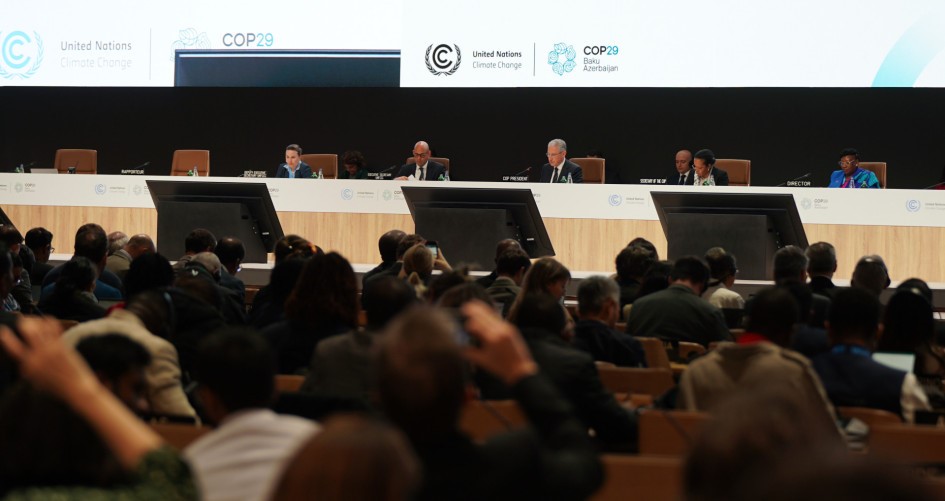
- 26 Nov 2024
In News:
The 29th UN Climate Change Conference (COP29), held in Baku, Azerbaijan, focused on enhancing climate finance, adaptation measures, and global cooperation.
Key Outcomes of COP29:
- Climate Finance: A new goal was set to triple climate finance for developing countries to USD 300 billion annually by 2035. The total climate finance target aims for USD 1.3 trillion annually by 2035.
- Carbon Markets: The conference operationalized Article 6 of the Paris Agreement, which establishes frameworks for carbon credit trading between countries. It also launched the Paris Agreement Crediting Mechanism, ensuring safeguards for human rights and the environment.
- Transparency and Adaptation: COP29 saw 13 countries submit their Biennial Transparency Reports, promoting greater accountability. The Baku Adaptation Roadmap was launched to speed up National Adaptation Plans (NAPs) in Least Developed Countries (LDCs).
- Gender and Inclusivity: A new Gender Action Plan was developed, and the Lima Work Programme on Gender was extended for another 10 years. Over 55,000 people, including civil society, Indigenous peoples, and youth, participated.
- Global Climate Action: The 2024 Yearbook of Global Climate Action highlighted the role of non-Party stakeholders like businesses and sub-national actors in combating climate change.
India’s Role at COP29: India played an active role in highlighting resilient infrastructure initiatives like the Coalition for Disaster Resilient Infrastructure (CDRI) and advocated for financial resources to support Small Island Developing States (SIDS). India also pushed for solar energy adoption through the International Solar Alliance (ISA) and promoted gender-inclusive climate policies. India co-hosted the LeadIT summit with Sweden, focusing on industrial decarbonization.
Challenges at COP29:
- Inadequate Finance: Despite ambitious targets, many countries felt the financial commitments were insufficient and distant.
- Private Sector Dependency: The reliance on private sector contributions raised concerns about the reliability of funding.
- Emission Reduction Gaps: There was a lack of sufficient pledges to meet the 1.5°C global warming target, with rising emissions.
- Geopolitical Conflicts: Disputes over issues like the Carbon Border Adjustment Mechanism (CBAM) hindered progress.
India’s Carbon Credit Framework:
India introduced the Energy Conservation (Amendment) Act, 2022, establishing a domestic carbon market and setting a legislative framework for carbon credit trading. This aligns with India’s NDCs and aims to support sustainable growth while reducing emissions. However, concerns about the integrity of carbon credits and potential "greenwashing" need to be addressed through rigorous verification systems.
Conclusion:
COP29 marked progress in scaling up climate finance, carbon markets, and adaptation efforts, but significant challenges remain, especially in finance, emission reductions, and geopolitical cooperation. India's initiatives in carbon credit frameworks and resilience are steps toward a sustainable future. Moving forward, a collaborative, transparent, and adaptive approach is crucial to meet global climate goals.
Earning Instead of Burning
- 21 Nov 2024
In News:
Paddy straw burning, prevalent in Punjab, Haryana, and Uttar Pradesh, contributes to severe air pollution, especially during the post-harvest period in October and November. Despite various government measures and subsidies to reduce stubble burning, it continues due to economic and operational constraints faced by farmers. To address this issue, innovative technologies for the productive use of paddy straw need to be explored.
Stubble Burning: Causes and Consequences
Reasons for Stubble Burning
- Short Crop Cycles: The narrow window between paddy harvest and wheat sowing forces farmers to burn straw to prepare fields quickly.
- Economic Constraints: High costs of alternative residue management methods.
- Lack of Awareness: Farmers are often unaware of sustainable alternatives.
- Limited Mechanization: Availability of crop residue management machinery is inadequate.
- Policy Gaps: Ineffective enforcement of regulations and insufficient incentives.
Consequences of Stubble Burning
- Air Pollution: Emission of harmful pollutants like PM2.5, CO2, and CO contributes to air quality degradation.
- Health Hazards: Increased respiratory illnesses due to the inhalation of toxic fumes.
- Soil Degradation: Loss of essential nutrients and organic matter.
- Climate Change: Stubble burning releases greenhouse gases into the atmosphere.
- Economic Costs: Increased health care costs and loss of soil fertility.
Technologies for Paddy Straw Utilization
Large-Scale Technologies
- Direct Combustion:Burns rice straw under controlled conditions to generate heat for cooking and industrial uses. While its calorific value is lower than that of petrol and diesel, it is still viable for local energy generation.
- Pyrolysis and Gasification:
- Pyrolysis: Converts rice straw into bio-oil through heating at 200-760°C in the absence of oxygen.
- Gasification: Converts rice straw into syngas at higher temperatures (480-1,650°C) with limited oxygen. Challenges include low gas production and tar accumulation.
- Biochar Production:Rice straw is incinerated at lower temperatures to produce biochar, which is used as a soil conditioner to improve fertility, water retention, and reduce greenhouse gas emissions.
- Power Generation:Biomass-based power plants use rice straw to generate electricity, providing a sustainable energy source, especially for rural areas. States like Punjab, Haryana, and Uttar Pradesh are scaling up such plants.
- Pellet Production:Rice straw is compressed into compact pellets, improving its density, transportability, and combustion efficiency. These pellets can partially replace coal in power plants, offering an alternative use for crop residue.
- Biofuels:Conversion of rice straw into biofuels like ethanol and biogas helps reduce dependency on fossil fuels and supports the renewable energy transition.
- Paper Production:Rice straw, with its high cellulose content, is used as an eco-friendly alternative to wood in the paper and pulp industry, reducing environmental impact.
Small-Scale Technologies
- Composting:Rice straw can be composted to produce organic fertilizer, enhancing soil health. Vermicomposting is another effective method, though awareness among farmers remains low.
- Mushroom Cultivation:Rice straw serves as an ideal substrate for growing mushrooms, particularly species like Volvariellavolvacea. This practice provides an additional income source for farmers.
- Silica Extraction:Rice straw contains high silica content, which can be extracted for industrial applications like construction and electronics.
- Fodder for Ruminants:Though rice straw is low in digestibility due to high silica content, it can be used as animal feed after pre-treatment, such as drying, grinding, or chemical processes to enhance its nutritional value.
- Adsorbent for Pollution Control:Rice straw can be used to remove heavy metals and toxins from contaminated water, showing promise in environmental cleanup efforts.
- Soil Incorporation:Instead of burning, rice straw can be incorporated directly into the soil to improve fertility, moisture retention, and crop yield. This practice is already being adopted in regions like Punjab and Haryana.
Conclusion: Path Forward
Stubble burning continues to be a significant environmental challenge, but the development and adoption of technologies for utilizing paddy straw can offer viable solutions. Both large- and small-scale technologies can convert rice straw into valuable products like biofuels, power, and fertilizers. To ensure widespread implementation, efforts must be made to increase awareness among farmers and stakeholders, coupled with strong policy support and infrastructural investment. A collaborative approach involving the government, industries, and farmers is essential for sustainable management of rice straw, benefiting both the environment and the economy.
Sustainable Path to Net-Zero for India
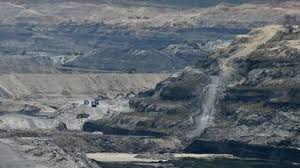
- 19 Nov 2024
In News:
India's commitment to achieving net-zero carbon emissions by 2070 presents a significant challenge, with only 45 years remaining to reach this ambitious target. The path to net-zero requires a balancing act between economic development, energy security, and climate adaptation. India’s efforts to meet its climate goals will be shaped by multiple factors, including resource constraints, land use, and financial limitations.
Why Net-Zero at All?
- Scientific Consensus on Climate Change
- Climate change is a growing concern, with the global temperature rise already reaching 1.1°C above pre-industrial levels.
- To avoid catastrophic impacts, the world needs to limit the temperature rise to 1.5°C. The remaining global carbon budget for this target is around 400-500 billion tonnes of CO?.
- Necessity of Sharp Emission Reductions
- Countries must drastically reduce emissions to stay within the carbon budget. Achieving net-zero emissions is essential for maintaining global climate stability.
Equity in Net-Zero Transitions
- Developed vs. Developing Countries
- Developed nations, historically responsible for a large share of emissions, are expected to lead the transition. However, they have not met the financial and technological support commitments for developing countries.
- Developing nations like India, with low per capita emissions, are under pressure to balance climate action with economic development.
- Climate Justice
- India’s per capita emissions are among the lowest globally, but the richest 10% of Indians contribute significantly to national emissions, exacerbating inequality.
- The impacts of climate change disproportionately affect the economically weaker sections, making the transition to net-zero not only an environmental challenge but a social justice issue as well.
The Challenge of Balancing Development and Sustainability
- Limits of India’s Resources
- India faces resource constraints, including land, water, and biodiversity, which limit the feasible expansion of renewable energy capacity.
- Meeting energy demands while ensuring food security, forest cover, and biodiversity preservation becomes increasingly challenging as energy requirements rise.
- Sustainable Consumption vs. Aspirational Lifestyles
- India’s aspiration to emulate the developed world’s lifestyle is unsustainable due to limited resources, which could lead to severe consequences like groundwater depletion, heat stress, and biodiversity loss.
- The focus should be on sufficiency consumption corridors, ensuring that consumption meets developmental goals without exceeding sustainable limits.
Projected Power Demand and Renewable Energy Targets
- Rising Power Demand
- India’s power demand could increase nine to ten-fold by 2070. Meeting this demand entirely via renewable energy requires significant expansion in energy generation capacity:
- 5,500 GW of solar energy
- 1,500 GW of wind energy
- India’s power demand could increase nine to ten-fold by 2070. Meeting this demand entirely via renewable energy requires significant expansion in energy generation capacity:
- Land Use Constraints
- To meet these targets, India must address land-use trade-offs. Expanding beyond 3,500 GW of solar and 900 GW of wind would require significant compromises in land availability for other uses, including agriculture and conservation.
Strategic Pathways to Net-Zero: Demand and Supply Measures
- Demand-Side Measures
- Energy-efficient construction: Use of better materials and passive designs to reduce cooling energy demand.
- Urban transport: Shift to public and non-motorized transport to reduce energy consumption in cities.
- Dietary choices: Promoting sustainable dietary practices to reduce the carbon footprint of food systems.
- Electrification: Focus on alternative fuels and energy-efficient appliances.
- Supply-Side Measures
- Decentralization of Energy Production: Expanding rooftop solar panels and solar pumps for agriculture.
- Nuclear Power Expansion: Increase nuclear energy to provide a low-carbon baseload and complement renewable sources like solar and wind, which are intermittent.
The Role of International Cooperation and Financial Support
- Global Cooperation
- Global climate action requires alignment between national interests, which may not always coincide, as seen in the context of the U.S. presidential election potentially influencing global climate policy.
- India’s path to net-zero depends heavily on international climate financing, technology transfer, and collaborative efforts to address climate justice.
- Equitable Financing for Developing Countries
- Developed countries are expected to provide financial support to developing nations like India to achieve climate goals. However, this support has been insufficient to date.
Conclusion: India’s Balancing Act
India faces a challenging balancing act as it seeks to provide quality of life for its growing population while achieving its climate adaptation and mitigation goals. The path to net-zero will require careful management of economic growth, energy production, and resource conservation. India must focus on demand-side strategies to reduce energy consumption and increase efficiency while expanding renewable energy infrastructure in a sustainable manner. Additionally, international cooperation and financial support will be crucial in ensuring that India’s transition to net-zero is equitable, efficient, and aligned with its developmental priorities.
Andhra Pradesh's Natural Farming Model
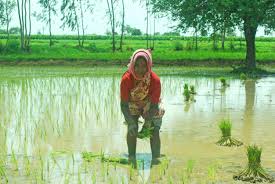
- 18 Nov 2024
In News:
Andhra Pradesh's (AP) natural farming model presents a transformative opportunity to reshape the state’s agricultural landscape by 2050. An analysis by the Food and Agriculture Organization (FAO), in collaboration with the AP government, reveals how scaling natural farming could employ more farmers, increase incomes, and foster sustainable agricultural practices, potentially surpassing the benefits of conventional industrial agriculture.
AgroEco2050: Exploring Two Agricultural Futures
The AgroEco2050 initiative aimed to envision two possible futures for Andhra Pradesh’s agricultural systems by 2050:
- Industrial Agriculture Path: Focusing on intensification of conventional farming, relying heavily on chemicals, machinery, and monocultures.
- Natural Farming Path: Expanding agroecological practices, relying on regenerative, chemical-free farming methods to create more jobs, better livelihoods, and improve the environment.
The study compared these pathways, analyzing their impacts on employment, income, food production, biodiversity, and land use.
Key Findings: Natural Farming’s Impact on Employment and Income
- Employment Growth
- By 2050, natural farming would employ twice as many farmers as industrial agriculture: 10 million compared to 5 million.
- Unemployment in natural farming would decrease to 7%, in stark contrast to a projected 30% unemployment rate in the industrial agriculture scenario.
- Farmer Income
- Natural farming is expected to be more profitable for farmers due to lower input costs (seeds, fertilizers, machinery) and higher market prices for high-quality produce.
- The income gap between farmers and non-farmers, which stood at 62% in 2019, would decrease to 22% under natural farming by 2050, a sharp improvement compared to the 47% gap predicted under industrial agriculture.
What is Natural Farming?
Natural farming is an ecological, chemical-free farming system that emphasizes the use of locally available resources. Key practices include:
- Biodiversity-based pest management
- On-farm biomass recycling (e.g., mulching)
- Indigenous techniques like using cow dung and urine for soil fertility.
Globally recognized as a form of regenerative agriculture, it offers a sustainable alternative to industrial agriculture by sequestering carbon and restoring soil health.
Global Adoption
States like Andhra Pradesh, Karnataka, Himachal Pradesh, and others are already adopting natural farming. While still evolving, its acceptance among farmers is steadily growing.
Zero Budget Natural Farming (ZBNF) in Andhra Pradesh
Origin and Growth
- In 2016, Andhra Pradesh launched the Zero Budget Natural Farming (ZBNF) initiative to offer a sustainable alternative to capital-intensive agriculture.
- This program, implemented by RythuSadhikaraSamstha, targets covering 6 million farmers across 6 million hectares.
National Recognition
The ZBNF approach gained national attention when it was featured in the 2019 Union Budget, aimed at doubling farmers' incomes by 2022. The central government now promotes this model under the Paramparagat Krishi Vikas Yojana (PKVY).
Challenges in Scaling Natural Farming
- Farmer Training and Support
- Farmers need ongoing education and support to transition effectively to natural farming. Current training systems often fail to address the full scope of their needs.
- Certification Barriers
- The certification process for organic farming, including Participatory Guarantee Systems (PGS) and third-party certifications, is complex and costly, presenting a barrier for small-scale farmers.
- Marketing and Procurement Challenges
- There is a lack of effective marketing systems for organic products, which hampers the ability of farmers to sell their produce at fair prices.
- Without strong procurement or buy-back systems, farmers may struggle to find markets for their products.
- Policy and Funding Gaps
- Organic and natural farming programs still receive minimal funding compared to subsidies for chemical fertilizers, impeding large-scale adoption.
- Slow state-level implementation and a continued reliance on chemical inputs also delay the widespread shift to natural farming.
Moving Forward
- Scientific Research on Yields
- To address concerns about lower yields for staple crops, more scientific research is needed to assess the long-term viability of natural farming, especially for crops like wheat and rice, which are crucial for India’s food security.
- Localized Adoption
- Natural farming may be best suited for non-staple crops or localized farming, balancing sustainability with the need for food security.
- Risk Mitigation for Food Security
- Careful evaluation of natural farming’s impact on staple crop yields is necessary to avoid the food security risks witnessed in countries like Sri Lanka, where a sudden shift to organic farming led to reduced yields and increased prices.
Conclusion
The Andhra Pradesh natural farming model offers a promising alternative to industrial agriculture, with the potential to create jobs, improve farmers' incomes, and promote environmental sustainability. However, for this vision to become a reality, significant efforts must be made to address challenges related to training, certification, marketing, and funding. With continued research, policy support, and community involvement, natural farming can play a crucial role in feeding the future and promoting a more sustainable agricultural system.
Zeroing in on Methane Diplomacy, at COP29
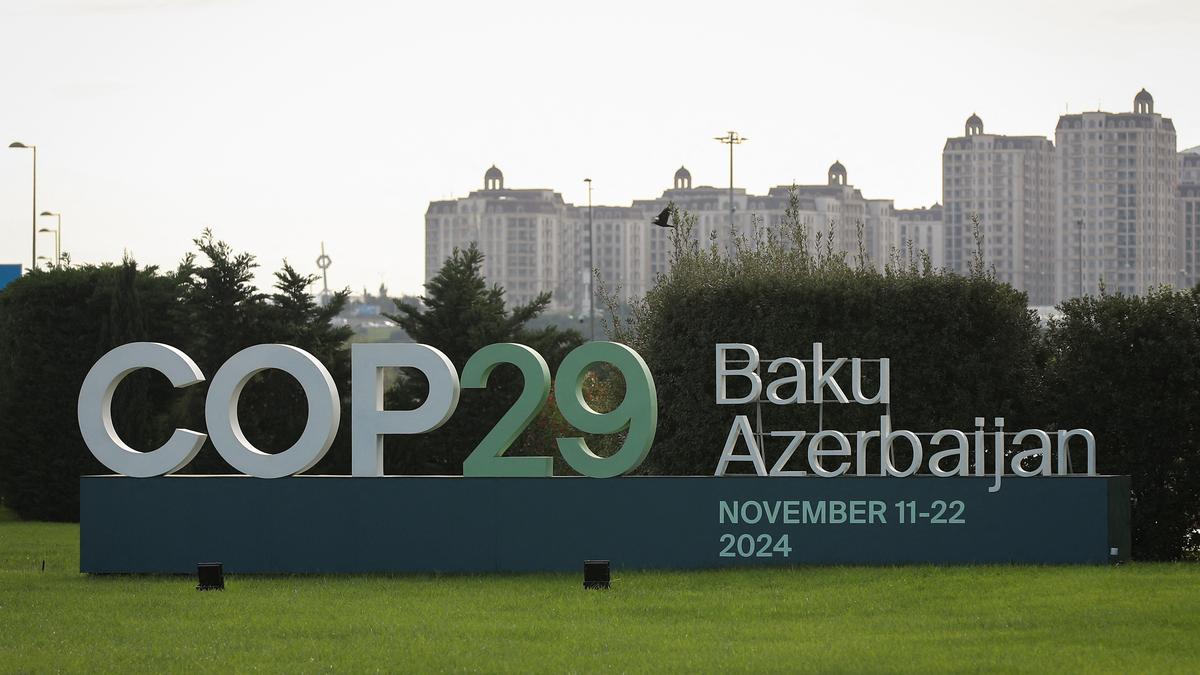
- 07 Nov 2024
In News:
From November 11 to 22, 2024, global leaders will gather in Baku, Azerbaijan, for the 29th Conference of Parties (COP29) under the United Nations Framework Convention on Climate Change (UNFCCC). This year’s summit, known as the Finance COP, will focus on setting a new global climate finance target—the New Collective Quantified Goal (NCQG).
A key focus of the summit is the reduction of methane emissions, as countries aim to curb near-term temperature increases, which buys critical time for long-term CO2 reductions necessary for stabilizing climate change.
U.S.-China Collaboration and Methane Reduction
US-China Collaboration Despite Geopolitical Tensions
Despite ongoing geopolitical tensions, the United States and China have found common ground on the issue of methane reduction. Both nations recognize the importance of addressing methane emissions, which are more potent in the short term than CO2. They, along with the United Arab Emirates, organized a summit at COP28 to discuss methane and other non-CO2 pollutants.
China’s National Plan for Methane Emissions
In November 2023, China launched its first national methane reduction plan, emphasizing capacity-building efforts over explicit reduction targets. This plan marked a significant step in China’s climate policy, underscoring its commitment to mitigating methane emissions alongside the U.S.
Given that China and the U.S. are the two largest contributors to methane emissions globally, their collaboration presents a significant opportunity for global climate mitigation efforts. India, the third-largest emitter of methane, could benefit from this partnership by seeking financial support and technical expertise to address its methane challenges.
India’s Methane Emissions Profile and Challenges
Emissions Breakdown
India’s Third Biennial Update Report to the UNFCCC indicates that in 2016, India emitted approximately 409 million tons of CO2-equivalent methane. The major sources of these emissions include:
- Agriculture: 74% (mainly from livestock and rice cultivation)
- Waste: 14% (unmanaged organic waste in landfills and dumpsites)
- Energy: 11%
- Industrial processes: 1%
Due to the dominant role of agriculture, India has been cautious about committing to stringent methane reduction targets. Initiatives like the Global Methane Pledge, which calls for a 30% reduction from 2020 levels by 2030, have not been fully embraced.
Environmental and Health Impact of Methane Emissions
Methane-related fires at waste dumpsites, such as the Bhalswa dump in Delhi (2022), have highlighted the broader environmental and health risks of methane emissions. These fires contribute significantly to air pollution, making it urgent for India to address methane in its waste management and agricultural sectors.
India’s Initiatives for Methane Reduction
Waste Management Programs
- Comprehensive Waste Management Framework India’s waste management sector is a significant source of methane, contributing 14% of the nation’s total emissions. Although a comprehensive regulatory framework for waste management has been developed, implementation remains slow due to local capacity constraints and financial limitations.
- Innovative Solutions Indore, a city in Madhya Pradesh, has pioneered waste sorting and biomethane production. The city's initiative includes:
- Sorting organic waste
- Converting it into biogas to fuel city buses
This model has gained national attention and is being considered for replication in other cities.
- GOBARdhan Scheme Launched as part of the Swachh Bharat Mission-Urban 2.0, the Galvanizing Organic Bio-Agro Resources Dhan (GOBARdhan) scheme encourages rural communities to convert cattle manure and other organic waste into biogas and compost, reducing methane emissions from livestock waste while providing additional income to rural households.
Agricultural and Livestock Emission Reduction
- National Mission for Sustainable Agriculture (NMSA) The NMSA promotes climate-resilient agricultural practices that reduce methane emissions. For example, Alternate Wetting and Drying (AWD) is a water-saving technique used in rice farming that reduces methane emissions by limiting anaerobic decomposition.
- National Livestock Mission Under the National Livestock Mission, practices such as improved fodder management, silage making, and Total Mixed Ration (TMR) feeding are being promoted. These practices reduce methane emissions from livestock by improving digestion and feed efficiency.
Opportunities for India at COP29
Leveraging U.S.-China Methane Partnership
COP29 offers India an opportunity to leverage the U.S.-China collaboration on methane reduction. By engaging with these two major emitters, India can seek:
- Financial support
- Technical assistance
- Capacity-building resources, particularly for its waste sector, which is a significant source of methane emissions.
Accurate data on methane emissions, such as satellite-based monitoring, can help India refine its emission inventories and enhance the effectiveness of its methane mitigation efforts.
Fast-Tracking India’s Methane Reduction Efforts
Although methane is not the primary focus at COP29, India has an opportunity to fast-track its efforts in methane reduction. The country's existing policies and initiatives, such as waste management programs and agricultural missions, provide a foundation upon which international collaboration can build.
Recent data from satellite monitoring in cities like Delhi and Mumbai shows that actual methane emissions from waste dumpsites may be 50%-100% higher than previously estimated, highlighting the urgency of addressing this issue.
Conclusion
Although methane may not dominate the COP29 agenda, it represents a critical pathway for India to accelerate its climate action. With the groundwork already laid through domestic policies and innovative solutions, India now requires enhanced financial and technical backing to scale up its methane reduction initiatives. By engaging proactively at COP29, India has a unique opportunity to secure the resources needed to tackle methane emissions, benefiting both its citizens and the global fight against climate change.
Key Takeaways from COP-16: Convention on Biological Diversity
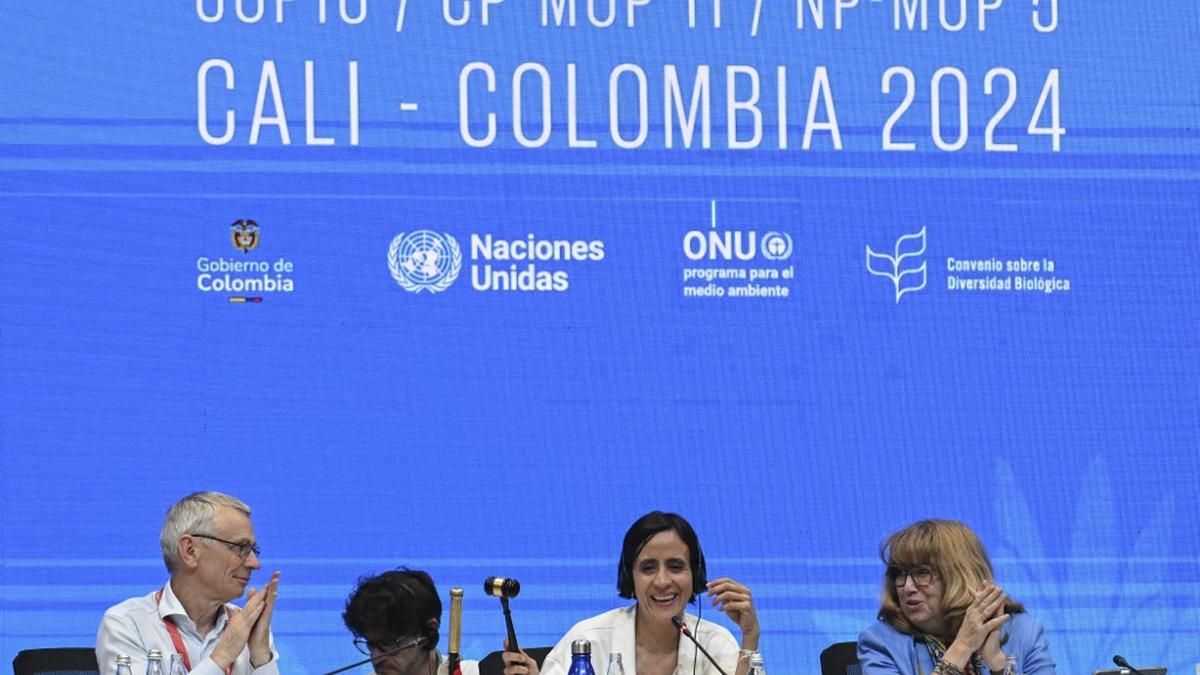
- 03 Nov 2024
In News:
The 16th edition of the Convention of Biological Diversity (CBD) in Cali, Colombia was concluded.
Key Agreements at COP-16
- Establishment of the Cali Fund
- Purpose: To ensure equitable benefit-sharing from the use of Digital Sequence Information (DSI) on genetic resources.
- Focus on Indigenous Communities: At least 50% of the Cali Fund will support Indigenous peoples and local communities, with special emphasis on women and youth.
- Creation of a Permanent Subsidiary Body
- Inclusion of Indigenous Peoples: A new body will ensure the active participation of Indigenous groups in biodiversity conservation and policy discussions.
- Resource Mobilisation Strategy
- Target Funding: The conference agreed on a strategy to secure USD 200 billion annually by 2030 to support global biodiversity initiatives.
- Kunming Biodiversity Fund: A contribution of USD 200 million from China to support biodiversity funding.
- Management of Invasive Alien Species
- New Guidelines: Proposals for databases, cross-border trade regulations, and enhanced coordination with e-commerce platforms to manage invasive species.
- Identification of Ecologically or Biologically Significant Marine Areas (EBSAs)
- Enhanced Process: COP-16 agreed on an evolved process for identifying EBSAs, a critical aspect of marine conservation.
- Global Action Plan on Biodiversity and Health
- One Health Approach: Approval of a global action plan to curb zoonotic diseases, promote health, and safeguard ecosystems.
India’s Contribution at COP-16
Updated National Biodiversity Strategy and Action Plan (NBSAP)
- Financial Commitment: India plans to invest ?81,664 crore (USD 9.8 billion) from 2025-30 on biodiversity conservation.
- Focus Areas: India highlighted efforts such as the establishment of the International Big Cat Alliance, expansion of Ramsar sites, and increased spending on biodiversity from 2018-2022.
International Finance Support
- Global Partnerships: India emphasized the need for international finance to meet biodiversity targets, particularly under the Kunming-Montreal Global Biodiversity Framework (KMGBF).
Key Outcomes from COP-16
- New Mechanisms for Biodiversity Conservation
- Cali Fund: Ensures equitable benefit-sharing from genetic resources.
- Permanent Subsidiary Body: Facilitates the inclusion of Indigenous peoples in policy-making.
- Funding and Resource Mobilization
- USD 200 Billion Annually: Strategy to secure funding for biodiversity initiatives.
- Redirecting Harmful Subsidies: Agreement to redirect USD 500 billion in harmful subsidies by 2030.
- Biodiversity and Human Health
- Global Action Plan on Biodiversity and Health: Aimed at preventing zoonotic diseases and promoting human, animal, and environmental health.
Challenges in Biodiversity Protection
Key Threats to Biodiversity
- Population Growth and Resource Demand: Increasing population and demand for biological resources lead to over-exploitation.
- Habitat Degradation and Climate Change: Destruction of ecosystems and climate change threaten species globally.
- Invasive Species: Introduction of non-native species harms local biodiversity.
- Government Policies: Policies that prioritize development without environmental safeguards contribute to biodiversity loss.
Gaps in Global Biodiversity Framework
- Weak Legal Language: Concerns about insufficient legal protection for critical ecosystems.
- Lack of Implementation Mechanisms: Absence of mandatory review mechanisms for biodiversity targets.
Kunming-Montreal Global Biodiversity Framework (KMGBF)
Framework Overview
- Adoption: Adopted at COP-15 in 2022, the KMGBF sets 23 action-oriented targets for biodiversity by 2030.
- Key Goals: Includes restoring 30% of degraded ecosystems and reducing the risk of invasive species by 50%.
- Living in Harmony with Nature: The framework envisions achieving biodiversity targets and living sustainably with nature by 2050.
Way Forward: Moving from Agreements to Action
- Participation of Stakeholders - Inclusive Approach: Ensuring the involvement of all relevant stakeholders, including governments, businesses, and local communities, in biodiversity conservation.
- Integrated Resource Management - Ecosystem Approach: Promoting a holistic approach to managing biodiversity and natural resources.
- Strengthening Governance - Good Governance Practices: Encouraging better governance to prevent unregulated exploitation of natural resources.
- International Financial Support - Alignment with Financial Institutions: Aligning global financial institutions and multilateral development banks with biodiversity conservation goals.
WWF Living Planet Report 2024
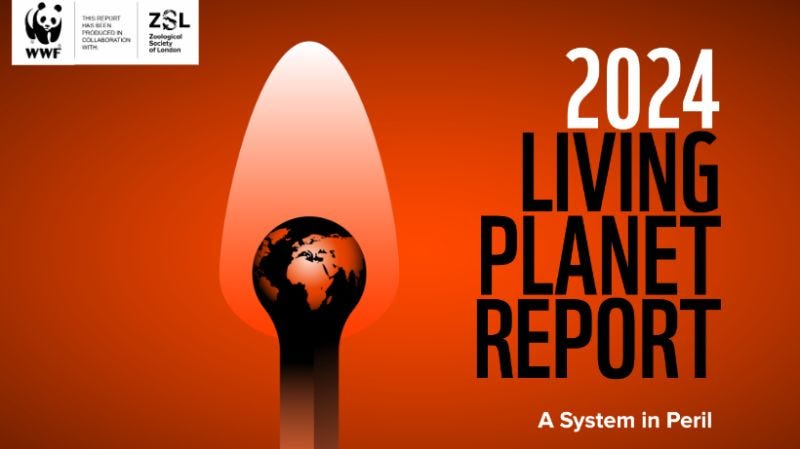
- 02 Nov 2024
In News:
- The WWF Living Planet Report 2024 highlights a drastic 73% decline in the average size of monitored wildlife populations globally from 1970 to 2020.
- The report underscores the urgent need for biodiversity conservation to maintain ecological balance, food security, and human health.
Key Findings of the 2024 Report
Wildlife Population Decline
- 73% Decline in monitored wildlife populations over the past 50 years (1970-2020).
- Freshwater species: Declined by 85%, the most significant drop.
- Terrestrial species: Declined by 69%.
- Marine species: Declined by 56%.
Main Threats to Wildlife
- Habitat Loss: Primary driver, particularly due to the expansion of food systems.
- Overexploitation: Over-hunting, fishing, and resource extraction.
- Invasive Species: Non-native species disrupt local ecosystems.
- Pollution: Water, air, and soil contamination, especially in Asia-Pacific.
- Disease: Emerging diseases impacting wildlife populations.
Ecosystem Risks and Tipping Points
- Decline in wildlife signals risks of ecosystem tipping points.
- Critical ecosystems, like the Amazon and coral reefs, face potential irreversible damage.
- Impact on global food security and livelihoods due to ecosystem collapse.
India’s Wildlife Status
- Vulture populations in India remain critically endangered.
- Tiger populations have increased to 3,682 (2022).
- Snow leopards have been successfully monitored with 718 individuals recorded.
Case Study: Chennai’s Wetland Loss
- 85% reduction in Chennai’s wetlands due to urban expansion, exacerbating flood and drought risks.
- Initiatives like the Tamil Nadu Wetland Mission aim to restore these wetlands to improve ecosystem resilience.
Impacts of Wildlife Decline
- Ecosystem Imbalance
- Disruption in predator-prey relationships, pollination, and nutrient cycles due to species decline.
- Leads to ecosystem instability and potential collapse.
- Loss of Biodiversity
- Reduced genetic diversity makes ecosystems less resilient to environmental changes.
- Increases vulnerability to diseases, natural disasters, and climate change.
- Threats to Food Security
- Pollinators like bees and insects are essential for crop yields.
- Loss of pollinators threatens global food supply and agriculture.
- Human Health Implications
- Healthy ecosystems regulate disease by controlling pest populations.
- Declining biodiversity increases the risk of zoonotic diseases, such as COVID-19.
- Economic Consequences
- Agriculture, fisheries, and tourism industries depend on healthy ecosystems.
- Decline in wildlife can lead to job losses and economic instability.
- Cultural and Social Impacts
- Wildlife holds cultural, spiritual, and recreational value for societies worldwide.
- Loss of iconic species diminishes cultural identities and opportunities for nature-based tourism.
Challenges in Biodiversity Conservation
- Inadequate National Actions
- Despite global commitments (e.g., Global Biodiversity Framework, Paris Agreement, UN SDGs), national actions are insufficient to meet 2030 biodiversity targets.
- Risk of crossing tipping points that could lead to irreversible ecosystem degradation.
- Key Drivers of Biodiversity Loss
- Habitat Loss: Driven by agriculture, urbanization, and infrastructure development.
- Climate Change: Rising temperatures, extreme weather, and altered precipitation patterns.
- Overexploitation: Unsustainable hunting, fishing, logging, and resource extraction.
- Pollution: Industrial, agricultural, and plastic pollution disrupt natural habitats.
- Invasive Species: Non-native species outcompeting and threatening native populations.
- Lack of Funding: Inadequate financial resources for effective conservation.
- Weak Policy and Enforcement: Poorly implemented habitat protection laws.
- Human-Wildlife Conflict: Increased interactions between expanding human populations and wildlife.
- Genetic Diversity Loss: Reduced genetic diversity makes species vulnerable to diseases and environmental changes.
- Awareness Gaps: Insufficient public awareness on the importance of biodiversity.
Conclusion and Way Forward
Policy and Action Recommendations
- Expand protected areas and restore ecosystems to halt biodiversity loss.
- Engage Indigenous communities in conservation and land management practices.
- Promote sustainable farming, reduce food waste, and encourage plant-based diets to lessen food production impacts.
- Shift to renewable energy and reduce fossil fuel use to mitigate climate change.
- Redirect investments from environmentally harmful sectors to nature-friendly industries.
WWF-India’s Call for Collective Action
- WWF-India advocates for collective action to align climate, conservation, and sustainable development policies.
- The goal is to ensure a resilient and thriving future for both biodiversity and human societies.
Stubble Burning and the Supreme Court's Ruling: Protecting the Right to a Pollution-Free Environment
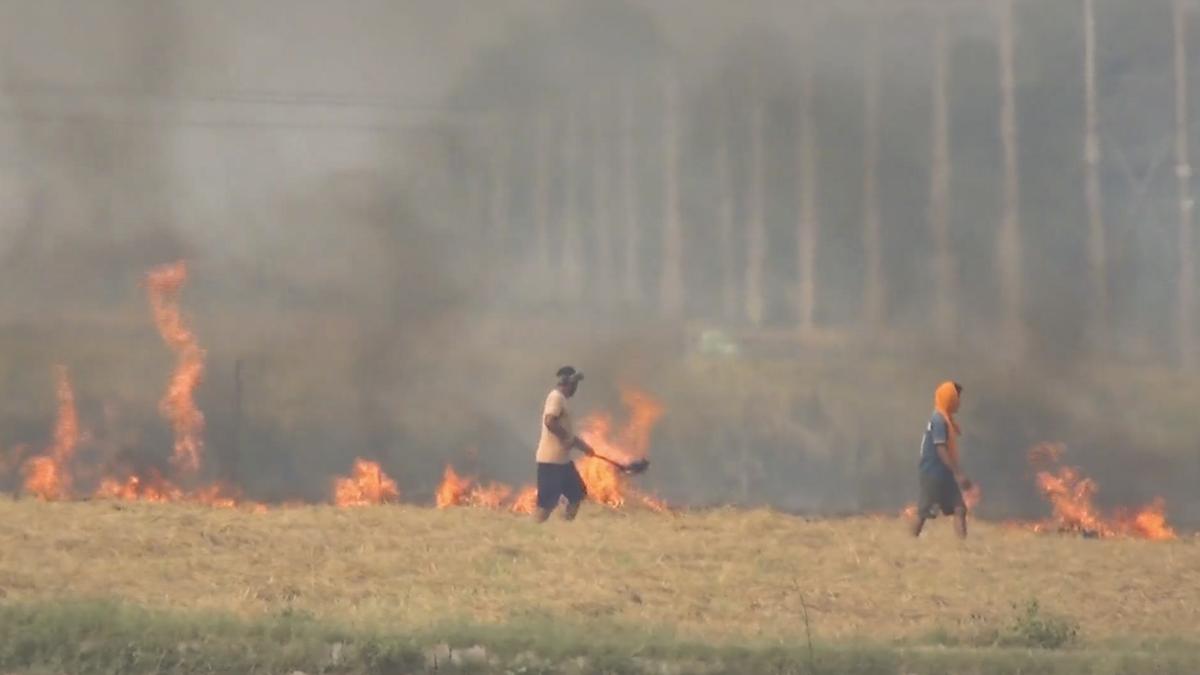
- 24 Oct 2024
Introduction
Recently, the Supreme Court of India expressed serious concerns about the ongoing issue of stubble burning in the states of Punjab and Haryana. The Court criticized the selective enforcement of penalties for stubble burning and emphasized that such practices violate citizens' fundamental right under Article 21 of the Indian Constitution, which guarantees the right to live in a pollution-free environment.
Court’s Observations on Stubble Burning
- The Supreme Court highlighted the failure of state governments in effectively implementing laws against stubble burning.
- Selective Enforcement: The Punjab and Haryana governments were accused of prosecuting only a few violators while allowing many others to escape punishment by paying a nominal fine.
- The Court observed that this approach is a blatant violation of the right to live in a pollution-free environment, which is guaranteed under Article 21 of the Constitution.
Right to a Pollution-Free Environment
- The Court emphasized that every citizen has the fundamental right to live in an environment free from pollution, as mandated by Article 21 of the Constitution.
- The Court questioned the effectiveness of current environmental regulations, specifically pointing out the lack of proper machinery to collect fines under Section 15 of the Environment (Protection) Act, 1986.
Impact of Stubble Burning
Stubble burning, primarily in the northern states of India, exacerbates air pollution, especially in Delhi and surrounding regions. The seasonal spike in air pollution during the months of October and November is largely attributed to farm fires. This not only worsens the air quality but also has severe implications for public health.
Environmental and Health Consequences
- Air Pollution: The burning of crop residues significantly contributes to the rise in PM2.5 and PM10 levels, leading to hazardous air quality.
- Soil Health: Burning crop residues depletes essential nutrients from the soil, reducing organic carbon content and harming soil fertility.
Health Risks
- Exposure to pollutants like particulate matter (PM) can lead to respiratory problems, heart diseases, and other health complications for the population, especially in densely populated areas like Delhi.
Legal and Institutional Shortcomings
- Inadequate Implementation: Despite laws and penalties being in place, the lack of an effective enforcement mechanism has resulted in the persistence of stubble burning.
- Toothless Penalties: The Supreme Court criticized the amended Section 15 of the Environment Protection Act, 1986, which replaced criminal penalties with financial fines for environmental violations. However, the lack of rules and appointed adjudicating officers has rendered this provision ineffective.
- No Serious Enforcement: The failure of the Central government and state authorities to implement effective penalties has led to widespread non-compliance with environmental laws.
Government Actions and Responses
Centre’s Efforts:
- The Central Government has introduced a Central Sector Scheme to promote agricultural mechanization for in-situ management of crop residue in Punjab, Haryana, Uttar Pradesh, and Delhi.
- The government provides financial assistance of up to 50% for the purchase of machinery, such as the Happy Seeder, to manage paddy stubble without burning.
- A total of ?3,062 crore has been released from 2018 to 2023 to tackle stubble burning.
State-Level Actions:
- The Punjab government has introduced cash incentives for farmers who refrain from burning stubble. Additionally, the state is offering non-fiscal incentives, such as access to panchayat land for storing paddy straw.
- The Pusa Decomposer, developed by the Indian Agricultural Research Institute (IARI), is a bio-enzyme used to decompose crop residue. It helps in turning the stubble into manure within 20-25 days, enhancing soil health.
Challenges for Farmers:
- Many farmers still prefer burning stubble due to high costs associated with alternative methods of residue management.
- The Happy Seeder and other machinery remain expensive and are not affordable for most small-scale farmers, leading them to resort to burning as the most cost-effective option.
Court’s Directive and the Way Forward
- The Supreme Court directed the Centre and state governments to ensure better enforcement of laws related to air pollution, vehicular emissions, and industrial pollution.
- The Court also urged the Union Government to consider Punjab’s request for additional funds to tackle the stubble burning issue and to strengthen the enforcement mechanism.
- Urgency for Action: The Court’s observations suggest that the existing framework needs urgent reforms to protect citizens’ right to a pollution-free environment.
Constitutional Provisions Related to Environmental Protection
India’s Constitution provides several provisions to ensure the protection of the environment:
Article 21: Right to Life and Environment
- In the landmark case Subhash Kumar v. State of Bihar (1991), the Supreme Court held that the right to life under Article 21 includes the right to a wholesome environment.
- This view was reiterated in Virender Gaur v. State of Haryana (1994), further strengthening the legal framework for environmental protection.
Directive Principles of State Policy
- Article 48A: The State is mandated to protect and improve the environment and safeguard forests and wildlife.
- Article 39(e) and 47: These Articles place a duty on the State to promote public health and ensure environmental protection.
Fundamental Duties
- Article 51A(g) places a duty on citizens to preserve and protect the environment.
Conclusion
The Supreme Court’s ruling highlights the urgent need for better implementation of environmental laws and the protection of citizens’ fundamental rights under Article 21. While government schemes are in place, a more robust and consistent approach is required to address the issue of stubble burning and air pollution. Immediate reforms in the enforcement mechanisms and incentives for farmers are crucial to achieve a sustainable, pollution-free environment in India.
Biodiversity COP16
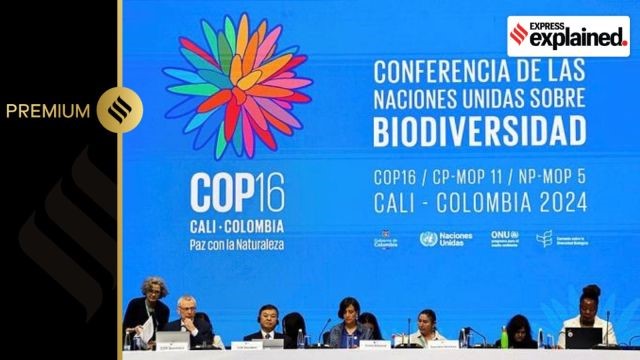
- 23 Oct 2024
In News:
The Convention on Biological Diversity (CBD), while historically overshadowed by climate change discussions, is now gaining increasing attention due to the growing recognition of the global biodiversity crisis. This evolving prominence highlights the need for urgent action to preserve ecosystems and halt biodiversity loss, which is intimately linked with the climate crisis.
Overview of the Convention on Biological Diversity (CBD)
- Origins and Objectives:
- The CBD emerged from the 1992 Rio Earth Summit, alongside the UN Framework Convention on Climate Change (UNFCCC).
- Main Goals:
- Protect global biodiversity.
- Restore ecosystems.
- Ensure equitable distribution of the benefits derived from biological resources.
- COP16 and the Kunming-Montreal Framework:
- The 16th Conference of Parties (COP16) marks the first meeting following the Kunming-Montreal Global Biodiversity Framework adopted at COP15 in 2022.
- The framework sets out four key goals and 23 targets to be achieved by 2030, including:
- Protect 30% of global lands and oceans by 2030.
- Restore 30% of degraded ecosystems by 2030.
The Growing Convergence Between Climate Change and Biodiversity
- Interlinkages Between Climate Change and Biodiversity:
- Mutual Impact:
- Climate change accelerates biodiversity loss by altering habitats and threatening species.
- In turn, ecosystem degradation contributes to climate change by releasing greenhouse gases (GHGs) from deforestation and soil degradation.
- Shared Drivers:
- Both crises are driven by unsustainable human activities, including over-exploitation of natural resources, deforestation, over-consumption, and pollution.
- Increasing Synergy:
- There is a growing realization of the need for integrated solutions that address both climate change and biodiversity loss simultaneously.
- Momentum for 30 x 30 Targets
- The 30 x 30 Commitment:
- The 30 x 30 targets are central to the Kunming-Montreal Framework, which includes:
- Conservation of 30% of the world's lands and oceans.
- Restoration of 30% of degraded ecosystems.
- These targets aim to ensure the preservation of biodiversity-rich areas and the restoration of degraded ecosystems globally by 2030.
- National Biodiversity Strategies and Action Plans (NBSAPs):
- Countries are required to develop and submit their NBSAPs (akin to Nationally Determined Contributions (NDCs) for climate change).
- As of now, only 32 countries have submitted their NBSAPs, with more expected during COP16.
- High Seas Treaty:
- A crucial agreement for achieving 30 x 30 targets is the High Seas Treaty (also called Biodiversity Beyond National Jurisdictions (BBNJ)), which focuses on:
- Establishing protected marine areas in biodiversity-rich regions beyond national jurisdictions.
- Ensuring regulation of human activities in these areas.
Access and Benefit Sharing: The Case of Genetic Resources
- Genetic Resources and Their Exploitation:
- The oceans, along with terrestrial ecosystems, harbor a wide variety of genetic resources that can be exploited for medical, commercial, and scientific purposes.
- Advances in biotechnology and digital sequencing of genetic material have raised issues about the equitable sharing of benefits from these resources.
- Nagoya Protocol and Benefit Sharing:
- The Nagoya Protocol (2010) set out guidelines for the access and fair sharing of benefits derived from genetic resources.
- At COP16, discussions will center on how genetic sequences (used in products such as medicines, crops, etc.) can be used fairly, ensuring that indigenous communities, who may be the original custodians of these resources, benefit equitably.
Finance Mechanisms for Biodiversity Conservation
- Financial Targets:
- One of the key goals of the Kunming-Montreal Framework is to mobilize $200 billion per year by 2030 for biodiversity conservation globally.
- Developed countries are expected to contribute $20 billion annually to developing nations, increasing to $30 billion by 2030.
- Phasing Out Harmful Subsidies:
- Countries are urged to eliminate perverse incentives that harm biodiversity, such as subsidies for:
- Over-fishing.
- Deforestation.
- Fossil fuel consumption.
- The goal is to repurpose such incentives to support sustainable practices and conservation efforts.
- New Financial Mechanisms:
- COP16 discussions will also focus on creating innovative financial mechanisms, such as:
- A biodiversity fund.
- Biodiversity credits, similar to carbon credits, which would allow countries or organizations to offset their biodiversity loss by investing in conservation projects elsewhere.
Challenges and the Way Forward
- Implementation of 30 x 30 Targets:
- The main challenge lies in translating ambitious goals into actionable plans at the national and local levels. Countries must not only submit action plans but also implement and monitor them effectively.
- Increased Global Cooperation:
- Addressing biodiversity loss requires collaboration between countries, industries, and local communities to ensure that efforts are comprehensive and inclusive.
- Public Awareness and Engagement:
- It is crucial to raise awareness about the importance of biodiversity conservation and the urgent need for collective action to mitigate the combined threats of biodiversity loss and climate change.
Conclusion: The Need for Urgent Action
The discussions at COP16 signal an important shift in how the world addresses biodiversity and its links to climate change. As countries continue to recognize the interconnectedness of these two crises, the outcome of the CBD negotiations could play a pivotal role in shaping global environmental policy. However, meeting the ambitious goals set forth by the Kunming-Montreal Framework requires strong political will, adequate financing, and effective global cooperation.
Climate Change and Methane Emissions in the Amazon Rainforest
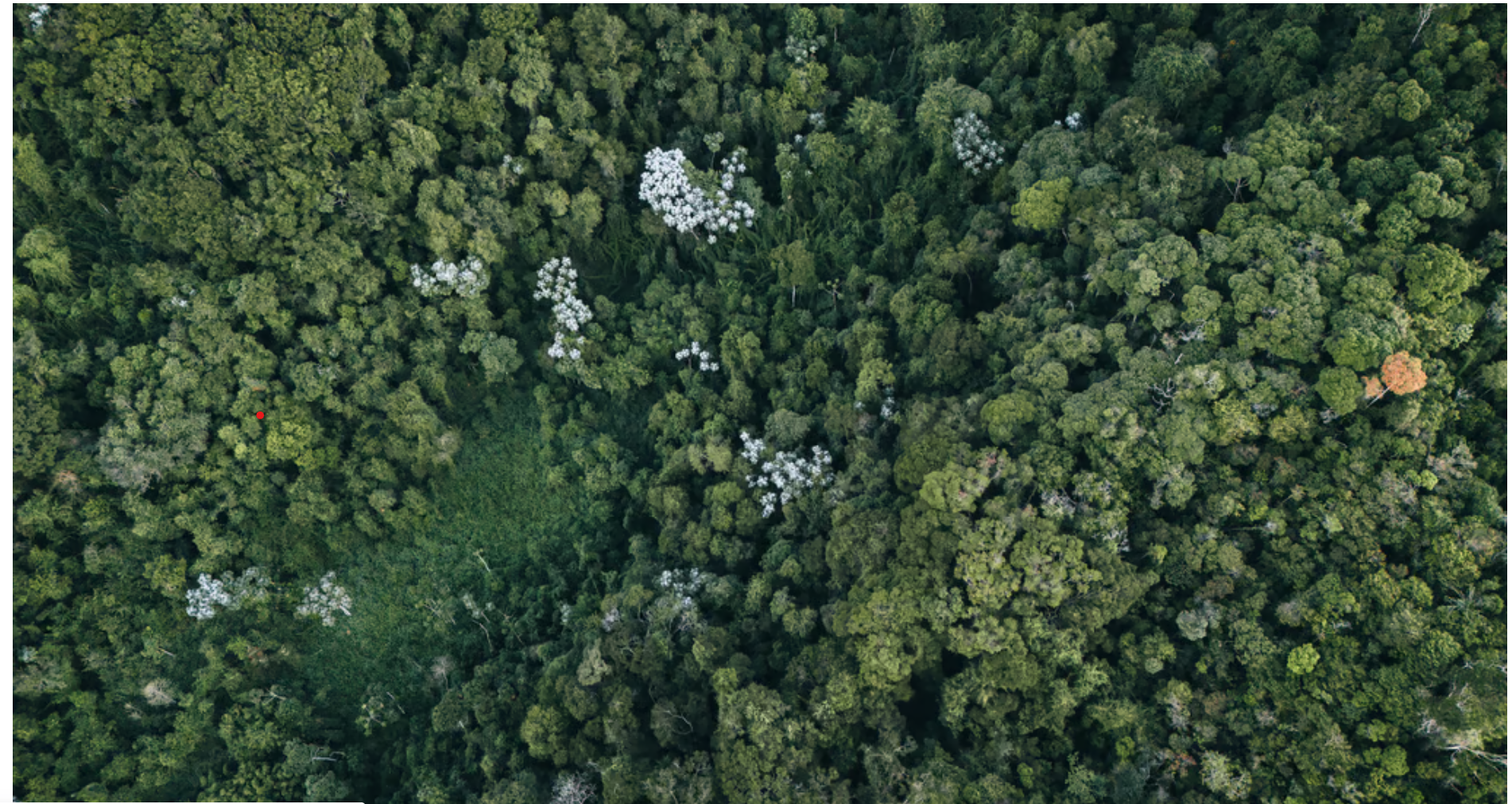
- 16 Oct 2024
Overview
Recent research from the University of São Paulo reveals that climate change is poised to significantly disrupt the methane cycle in the Amazon rainforest, with potential global repercussions. Rising temperatures and increased flooding are impacting microbial activity in both floodplain and upland forest soils, leading to contrasting changes in methane dynamics.
Key Findings
- Methane Uptake Reduction: The study indicates that methane absorption in upland forest soils could decrease by as much as 70% in warmer, drier conditions. This reduction diminishes the forest's role as a methane sink.
- Floodplain Contributions: Floodplains, which cover over 800,000 square kilometers during the rainy season, contribute up to 29% of global wetland methane emissions. Here, methane-producing microbes thrive due to the breakdown of organic matter.
Understanding the Methane Cycle
- Definition: The methane cycle encompasses the processes that control the production, consumption, and release of methane (CH4) in the environment.
- Microbial Roles:
- Methanogens produce methane, primarily in waterlogged conditions.
- Methanotrophs consume methane, living in drier, oxygen-rich soils. These interactions are critical in regulating methane levels in the atmosphere.
- Sources and Sinks: While wetlands and other environments release methane, hydroxyl radicals (OH) in the troposphere act as a natural sink, helping to oxidize methane into carbon dioxide.
Climate Change Impacts on the Methane Cycle
- Imbalance of Sources and Sinks: As global temperatures rise, the release of methane from soils may increase, exacerbating climate change effects.
- Melting Clathrates: Methane clathrates, trapped in cold sediments, are at risk as warming causes them to release methane, further contributing to greenhouse gas concentrations.
Global Consequences of Methane Disruption
- Climate Change Amplifier: Methane is the second most significant greenhouse gas, with a global warming potential 28 times greater than carbon dioxide over a century.
- Air Quality and Health: Increased methane emissions can lead to higher levels of tropospheric ozone, resulting in respiratory health issues and reduced air quality.
- Biodiversity Threats: The changes in methane dynamics can destabilize ecosystems, leading to shifts in species distributions and loss of biodiversity.
Balancing the Methane Cycle
To mitigate the impacts of methane emissions, various strategies can be employed:
- Enhanced Landfill Design: Utilizing gas collection systems to capture methane for energy rather than allowing it to escape.
- Livestock Management: Introducing feed additives to reduce methane emissions from ruminants.
- Sustainable Agricultural Practices: Implementing techniques like alternative wetting and drying in rice cultivation to lower methane output.
- Soil Health Improvements: Promoting organic fertilization and crop rotation to foster aerobic conditions in soils.
Research Insights
The study involved subjecting soil samples from floodplains and upland forests to elevated temperatures and varying humidity levels. Results indicated:
- Stable methane emissions in floodplains alongside an increase in methane-producing microbes.
- A significant decline in methane uptake in upland soils due to temperature sensitivity, with higher temperatures reducing microbial diversity.
Conclusion
The Amazon rainforest plays a crucial role in regulating global methane levels, and its response to climate change is vital for understanding future greenhouse gas emissions. As these ecosystems face increased pressure from rising temperatures and changing hydrological conditions, it becomes imperative to enhance our understanding and management of methane dynamics to mitigate broader climate impacts.
Bihar Under Water: An Analysis of Recurring Floods
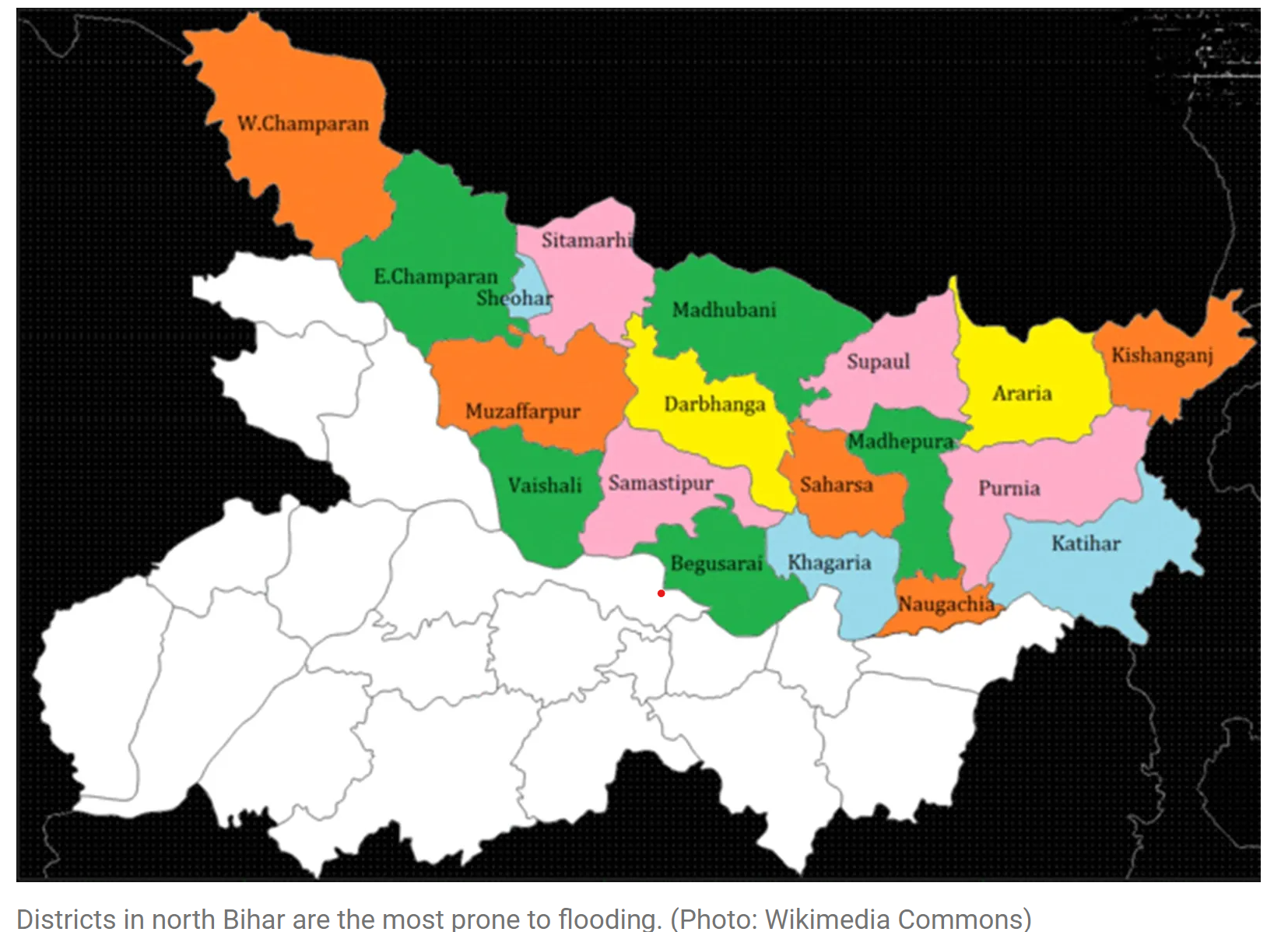
- 04 Oct 2024
Overview
Bihar is one of India's most flood-prone states, with 11.84 lakh people affected by annual flooding. The state grapples with the devastation of homes, crops, and livestock, prompting a cycle of recovery only to face similar disasters each year.
Geographical Vulnerabilities
Flood-Prone Conditions
- Demographics: 76% of North Bihar’s population lives under the threat of floods.
- River Systems: The state is crisscrossed by multiple snow-fed and rain-fed rivers, contributing to various flood types:
- Flash Floods: Rapid onset due to rainfall in Nepal (lead time: 8 hours).
- River Floods: Slower onset with a lead time of 24 hours, lasting over a week.
- Drainage Congestion: Extended flooding throughout the monsoon season (lead time: over 24 hours).
- Permanent Waterlogging: Caused by various factors including sedimentation and encroachments.
Factors Contributing to Flooding
- Himalayan Rivers: Rivers like Kosi, Gandak, and Bagmati carry significant sediment, leading to overflow during heavy rains.
- Waterlogging Causes: Silted rivers, encroachment of drainage channels, and local topographical features called Chaurs contribute to permanent waterlogging.
Historical Management Efforts
Embankments and Their Impact
- Kosi River: Known as the "sorrow of Bihar," embankments built in the 1950s to control the Kosi’s flow have led to unintended consequences.
- Sediment Accumulation: Narrowing of the river’s course has caused sediment to build up, increasing the riverbed height and flood risks.
- Current Crisis: Recent flooding was exacerbated by the release of 6.6 lakh cusec of water from the Birpur barrage in Nepal, leading to multiple embankment breaches.
Economic and Social Effects
Impact on Livelihoods
- While annual flooding may not always lead to significant loss of life, the economic repercussions are severe:
- Damage to crops and infrastructure.
- Loss of livestock and economic migration outside the state.
- Government Spending: Approximately Rs 1,000 crore is allocated annually for flood management and relief efforts.
Proposed Solutions
Structural vs. Non-Structural Approaches
- Dam Construction: Proposals for new barrages on the Kosi and other rivers have been discussed, but require cooperation from Nepal.
- Need for Comprehensive Strategies: Experts suggest a dual approach:
- Structural Solutions: Dams and embankments.
- Non-Structural Solutions: Policy development, risk mitigation, and improved community awareness.
Emphasis on Risk Reduction
- The Flood Atlas of Bihar advocates for minimizing flood risk rather than relying solely on structural measures.
- Focus on enhancing early warning systems and community preparedness is crucial for effective flood management.
Conclusion
Bihar’s unique geographical and socio-economic landscape necessitates a multifaceted approach to flood management. While structural solutions like dams are important, the state must also invest in non-structural measures that promote resilience and reduce vulnerability among its population.
INTEGRATED DEVELOPMENT OF WILDLIFE HABITATS (IDWH) SCHEME
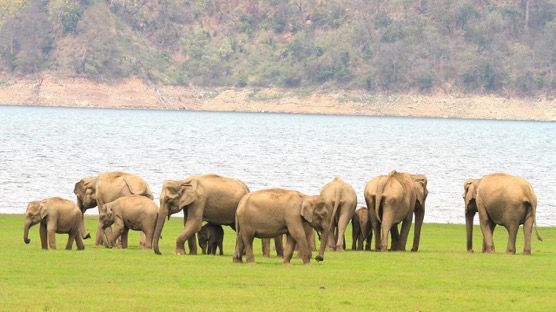
- 22 Sep 2024
In News:
The Union Cabinet has approved the continuation of the Integrated Development of Wildlife Habitats (IDWH) scheme for the 15th Finance Commission cycle, with a total outlay of ?2,602.98 crore. This scheme aims to enhance the conservation of wildlife and their habitats across India, building upon the earlier "Assistance for the Development of National Parks and Sanctuaries."
Overview of the Integrated Development of Wildlife Habitats (IDWH)
IDWH is a Centrally Sponsored Scheme designed to support various components critical to wildlife conservation. Key aspects of the scheme include:
- Support to Protected Areas: This encompasses national parks, wildlife sanctuaries, conservation reserves, and community reserves.
- Protection of Wildlife Outside Protected Areas: This aims to safeguard wildlife habitats and corridors beyond designated reserves.
- Recovery Programs: These initiatives focus on critically endangered species and their habitats.
Key Projects Under IDWH
The scheme integrates several prominent conservation projects:
- Project Tiger: Launched in 1973, this initiative seeks to ensure a viable population of Bengal tigers in their natural habitats. It employs advanced technologies such as the M-STrIPES application for effective management and monitoring.
- Project Elephant: Initiated in 1992, this project focuses on elephant conservation, addressing human-elephant conflicts, and promoting the welfare of domesticated elephants.
- Development of Wildlife Habitat: This includes Project Dolphin, which utilizes technology like Remotely Operated Vehicles (ROVs) for monitoring dolphin populations, and Project Lion, aimed at strengthening lion conservation efforts in line with the “Lion @ 2047” vision.
Significance of the Scheme
The IDWH scheme promises significant ecological and economic benefits:
- It is projected to generate over 50 lakh man-days of direct employment, alongside indirect job opportunities through eco-tourism and related activities.
- A total of 55 tiger reserves, 33 elephant reserves, and 718 protected areas will benefit from the scheme, enhancing biodiversity and ecosystem health.
- By supporting keystone species such as tigers, elephants, cheetahs, snow leopards, and lions, the scheme contributes to the overall integrity of these ecosystems.
The overall outlay for the three components for the 15th Finance Commission cycle as well as its remaining period:
S.No. Name of the Scheme Central Share State Share Total
1. Project Tiger 1575.00 955.00 2530.00
2. Project Elephant 182.58 54.00 236.58
3. Development of Wildlife Habitat 845.4 273.02 1118.42
*All figures in Rs. Crores Total 2602.98 1282.02 3885.00
Component of EFC 2024-25 2025-26
Project Tiger 365.00 365.00
Project Elephant 40.00 40.12
Development of Wildlife Habitat 195.00 183.16
*All figures in Rs. Crores Total 600 588.28
Arctic Sea Ice Changes May Alter India's Monsoon Patterns
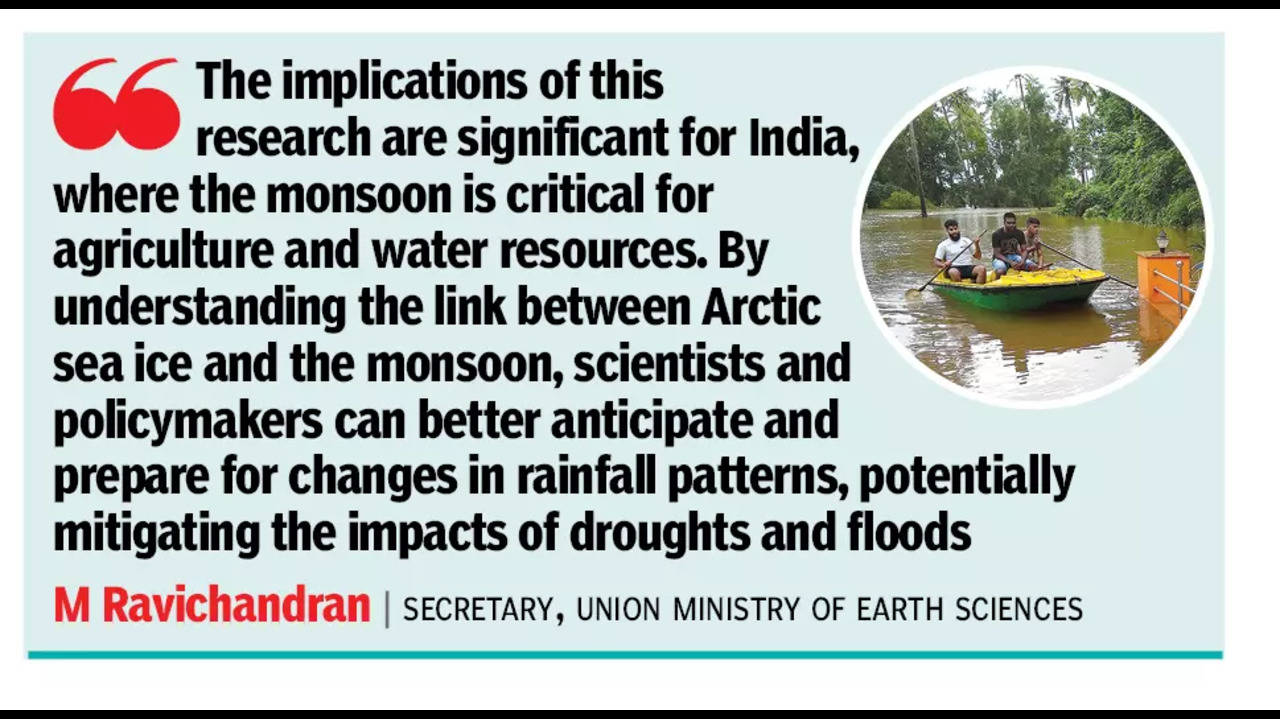
- 09 Sep 2024
In News:
A study by researchers from India’s National Centre for Polar and Ocean Research (NCPOR) has found that seasonal variations in Arctic Sea ice are impacting the Indian monsoon.
What is the Indian Summer Monsoon Rainfall?
The Indian Summer Monsoon Rainfall (ISMR), occurring from July to September, is one of the most significant monsoon systems globally. During the summer, the Central Asian and Indian landmasses heat up more quickly than the surrounding oceans. This temperature difference creates a low-pressure zone at the Tropic of Cancer known as the intertropical convergence zone (ITCZ). Trade winds from the southeast are then deflected toward the Indian subcontinent due to the Coriolis effect and the low pressure they encounter after crossing the equator. As these winds pass over the Arabian Sea, they pick up moisture and bring rain to India. The southwest monsoon divides into two branches over the Indian landmass. The Arabian Sea branch delivers rain to the west coast, while the Bay of Bengal branch brings rain to the eastern and northeastern parts of India. These branches converge over Punjab and Himachal Pradesh, with the Arabian Sea branch moving inward and the Bay of Bengal branch following the Himalayas.
Complexity of the Indian Summer Monsoon Rainfall
Recent climate models have revealed that the ISMR is influenced by the surface temperatures of the Indian, Atlantic, and Pacific Oceans. Additionally, the circum-global teleconnection (CGT), a large-scale atmospheric wave at mid-latitudes, also plays a significant role in affecting the monsoon.
Influence of Arctic Sea Ice on the Indian Monsoon
The study indicates that reduced sea ice in the central Arctic results in decreased rainfall in western and peninsular India, but increased rainfall in central and northern India. Conversely, lower sea ice levels in the upper latitudes, especially in the Barents-Kara Sea region, delay the onset of the monsoon and make it more unpredictable.
Other Atmospheric Systems Influencing the Pattern
When sea ice levels in the central Arctic rise, the heat transferred from the ocean to the atmosphere triggers cyclonic circulation at lower latitudes, such as the North Atlantic. This process enhances Rossby waves—fast-moving air currents created by Earth's rotation and temperature differences—which move from west to east. These waves cause high pressure over northwest India and low pressure over the Mediterranean region, strengthening the Asian jet stream over the Caspian Sea and shifting the subtropical easterly jet northward. This shift leads to increased rainfall in western and peninsular India. On the other hand, decreased sea ice in the Barents-Kara Sea generates an anticyclonic circulation (clear skies) over northwest Europe. This disturbance affects the upper atmosphere over subtropical Asia and India, resulting in increased rainfall in northeastern India while leaving central and northwest regions drier.
Role of Climate Change
Climate change accelerates the reduction of Arctic sea ice, which intensifies the variability and unpredictability of the ISMR. Lower Arctic sea ice contributes to more frequent and severe droughts in some areas, while causing excessive rainfall and flooding in others. The study underscores the urgent need for expanded research on climate dynamics and more accurate monsoon forecasts to address these changing patterns.
India Becomes Leading Plastic Polluter

- 08 Sep 2024
India has emerged as the top global plastic polluter, releasing 9.3 million tonnes (Mt) of plastic annually, accounting for nearly 20% of the world's total plastic emissions.
Top Plastic Polluters:
- India: 9.3 Mt
- Nigeria: 3.5 Mt
- Indonesia: 3.4 Mt
- China: Previously first, now fourth, due to improvements in waste management practices such as incineration and controlled landfills.
Understanding Plastic Emissions
Plastic emissions refer to plastic that escapes from managed systems into unmanaged or uncontrolled environments. These emissions can occur throughout the lifecycle of plastic, from production through to disposal.
Intergovernmental Negotiating Committee (INC)
The INC, established by the United Nations Environment Programme (UNEP) in 2022, is working towards creating a global binding treaty on plastic pollution. The committee addresses the entire plastic lifecycle:
- INC Sessions:
- INC-1: Punta del Este, Uruguay (November 2022)
- INC-2: Paris, France (May – June 2023)
- INC-3: Nairobi, Kenya (December 2023)
- INC-4: Ottawa, Canada (2024)
- INC-5: Scheduled for South Korea (November 2024)
Status of Waste Generation in India
- Underreported Waste Generation: Official figures estimate 0.12 kilograms per person per day, which may be higher in reality.
- Excluded Data:
- Waste from rural areas.
- Waste recycled by the informal sector.
- Open burning of uncollected waste.
Global Trends in Plastic Pollution
- Sources of Pollution:
- Global North: Littering is a major contributor.
- Global South: Uncollected waste is the primary source of plastic pollution.
- Top Polluting Countries: 69% of global plastic waste emissions come from 20 countries, mostly low- and middle-income nations.
- High-Income Countries: Although these countries produce more plastic waste, their advanced waste management systems prevent them from being top polluters.
India's Initiatives to Address Plastic Waste
- UNDP India’s Plastic Waste Management Program (2018-2024): Focuses on improving plastic waste management practices.
- Ban on Single-Use Plastics (SUP): Prohibits the manufacture, import, sale, and use of plastic bags thinner than 120 microns.
- Plastic Waste Management Rules (2022): Introduces Extended Producer Responsibility (EPR) for plastic packaging, with targets for recycling, reusing, and using recycled plastic.
- Swachh Bharat Mission: Launched in 2014 to improve waste management and eliminate open defecation.
- India Plastics Pact: Aims to transform the plastic lifecycle.
- Project REPLAN: Focuses on creating carry bags from a blend of plastic waste and cotton fibers.
- Un-Plastic Collective: Promotes a circular economy to reduce unnecessary plastic use and environmental impact.
- GoLitter Partnerships Project: Targets reducing marine plastic litter from fisheries and shipping.
Global Initiatives to Combat Plastic Pollution
- Closing the Loop: A UN Economic and Social Commission for Asia and the Pacific project to develop policies addressing plastic waste.
- Global Tourism Plastics Initiative: Aims to reduce plastic pollution from the tourism sector by 2025.
- EU Single-Use Plastics Directive (2021): Seeks to minimize plastic waste in the environment.
Challenges in the Way to Achieve Green Growth and Solutions

- 18 May 2024
Why is it in the News?
The recent heatwave has reminded us of the stark risks posed by climate change and highlighted the criticality of the efforts taken by the Conference of Parties (COP).
Context:
- The recent heatwave highlights the escalating threats of climate change, emphasizing the urgent need for robust climate action.
- The World Meteorological Organization (WMO) confirmed that 2023 was the warmest year on record, drawing renewed attention to carbon-intensive sectors like power and industry.
- As the third-largest carbon emitter globally, India faces increased scrutiny over its emissions.
- To address these challenges, significant efforts are being made to transition towards green energy, bolstered by various government initiatives and policies.
India's Green Growth Landscape: A Shift Towards Sustainable Practices
- Indian industries, particularly those in high-carbon emitting sectors, are increasingly acknowledging the importance of embracing sustainable practices.
- Many companies are taking proactive measures to transition towards renewable energy sources.
- For example, leading firms in refining, chemical production, and fertilizers are exploring the potential of Green Hydrogen to reduce their carbon emissions.
- These sectors are crucial in India's decarbonization efforts due to their significant contribution to greenhouse gas emissions.
- Although there are no mandatory regulations for green technology adoption, many entities are voluntarily adopting these technologies.
- This shift is driven by stakeholder expectations and the recognition of transition risks, such as policy, regulatory, technology, market, reputation, and legal challenges.
- Among these risks, technological risk is the most pressing concern for entities adopting green technologies.
Challenges in India's Transition to Green Growth:
Shifting from Fossil Fuels to Renewable Energy
- Fossil fuel-based power is India's primary source of carbon emissions.
- To meet the government's climate target of increasing non-fossil power to 50% by 2030, several schemes have been launched to boost renewable energy.
- ICRA projects that India will achieve this goal, with the share of non-fossil fuel-based installed capacity rising from 41% in 2022-23 to 59% by 2029-30.
- However, this transition requires significant investment, with an estimated Rs 11-12 lakh crore needed for renewable energy power and over Rs 5-6 lakh crore for transmission infrastructure and storage capabilities.
Ensuring Continuous Renewable Energy Supply:
- Ensuring a steady supply of renewable energy is crucial to reach the targeted level, given its intermittent nature.
- Hybrid renewable energy projects (wind and solar) complemented by energy storage systems can help achieve this.
- For sectors like steel and cement, the government must explore more carbon sequestration methods, such as installing carbon capture utilisation and storage (CCUS), which is inevitable for these hard-to-abate sectors.
Challenges in the Cement Sector:
- Cement manufacturing is resource and energy-intensive, producing an equivalent amount of carbon dioxide per tonne of cement.
- CCUS can reduce 60-70% of emissions during cement manufacturing, as most emissions are generated during clinker production.
- Niti Aayog's report estimates that the cement sector needs a CCUS capacity of two million tonnes per annum by 2030, with a capital cost of Rs 1,600-1,800 crore.
Challenges in the Steel Sector:
- Due to the abundance of virgin iron ore and limited domestic scrap, the domestic steel industry primarily uses coal as a reducing agent, resulting in high emissions.
- With India's 2070 net-zero target and carbon tax policies in some countries, domestic steelmakers are focusing on reducing their carbon footprint by 25-30% through technological interventions by 2030.
Government Efforts in India's Green Energy Transition and Carbon Reduction:
- Production Linked Incentive (PLI) Scheme: The PLI scheme offers financial incentives to manufacturers, encouraging them to establish production facilities in India.
- This strengthens the local solar manufacturing industry, making solar energy more affordable and accessible.
- Viability Gap Funding (VGF) for Offshore Wind and Battery Storage Projects: VGF schemes make large-scale renewable energy projects more financially viable, attracting private investment.
- Offshore wind and battery storage projects particularly benefit from this support, addressing the intermittent nature of renewable energy sources.
- Faster Adoption and Manufacturing of Electric Vehicles (FAME) Scheme: The FAME scheme provides subsidies for electric vehicle (EV) purchases and supports the development of charging infrastructure.
- This initiative aims to reduce vehicular emissions, decrease oil dependency, and promote sustainable urban mobility.
- National Green Hydrogen Mission: Green hydrogen, produced using renewable energy, has the potential to significantly reduce emissions in hard-to-abate sectors.
- The mission supports research, pilot projects, and production facilities, positioning India as a global leader in green hydrogen technology.
- Amendments to the Energy Conservation Act: The amendments include provisions for energy efficiency standards and energy management systems.
- These measures aim to reduce energy consumption, lower emissions, and promote sustainable industrial practices.
Recommendations for Overcoming Green Growth Challenges in India:
- Renewable Purchase Obligations (RPOs): The government should enforce mandatory percentages of electricity consumption from renewable sources.
- RPOs require power distribution companies and large consumers to purchase a specific proportion of energy from renewables, ensuring consistent demand and promoting sector growth.
- Implementation of the National Action Plan on Climate Change (NAPCC): Policymakers should devise strategies that promote sustainable development while tackling climate change.
- The NAPCC encompasses eight missions focusing on solar energy, energy efficiency, sustainable agriculture, and water conservation, enabling cross-sectoral efforts to integrate climate resilience and sustainability into national policies.
- Tax Incentives and Subsidies: Financial incentives should be provided to support renewable energy and green technologies.
- Tax benefits such as accelerated depreciation and tax holidays reduce investment burdens.
- Subsidies for solar power, electric vehicles, and energy storage systems make these technologies more accessible and appealing to consumers and businesses.
- Increased Viability Gap Funding (VGF): The government should address financial gaps in economically viable projects lacking initial investment.
- VGF schemes make large-scale renewable energy projects, like offshore wind farms and battery storage systems, more financially viable and reduce investment risks.
Conclusion
India's journey towards embracing green energy and sustainability is characterized by both formidable hurdles and promising prospects. The proactive steps taken by the government and the enthusiastic participation of diverse stakeholders are laying the groundwork for a more environmentally friendly tomorrow. Yet, reaching the ambitious climate goals demands persistent backing, significant financial injections, and a surge in technological advancements. In a world grappling with the intensifying effects of climate change, India's resolute pledge to slash carbon emissions and shift towards renewable energy stands as both an imperative and an inspiration for nations worldwide.
Constructed Wetlands: Solution for Wastewater Treatment in India

- 07 May 2024
Why is it in the News?
Constructed wetlands ecosystems can significantly contribute to sustainable industrial progress and the preservation of water resources.
Context:
- Industrial growth in India has led to major environmental issues, especially in managing industrial wastewater.
- Untreated or improperly treated industrial discharge into water sources causes severe threats to ecosystems, public health, and water security.
- With diverse sectors like manufacturing, textiles, chemicals, and mining, pollution is substantial.
- Traditional treatment methods often fail to address the complex pollutants in industrial wastewater, demanding a shift to comprehensive, nature-based solutions.
- Constructed wetlands offer a promising solution, providing effective treatment and significant environmental and economic benefits.
- These unique ecosystems combine the efficiency of natural processes with human innovation, presenting an eco-friendly alternative to conventional treatment methods.
What are Constructed Wetlands?
- A constructed wetland is a type of sustainable wastewater treatment system that is designed to look and function as a natural wetland does.
- Constructed wetlands are created for the purpose of treating wastewater from small, rural communities in an environmentally friendly way before allowing it to return to the water system safely.
- They are usually made up of a primary settlement tank where wastewater from the community is collected and from that, several ponds follow which are planted with wetland plants including reeds, rushes and sedges.
- The ponds are usually gently sloped towards a river to allow water to flow very slowly through the wetland before flowing away.
- Any particles that have been carried in the water will settle on the bottom and the plants and natural microorganisms (e.g. bacteria, algae and fungi) in the wetlands will break down and remove certain pollutants and elements e.g. phosphorus in the water.
- Constructed wetlands are typically divided into two categories: Subsurface flow (SSF) and surface flow (SF).
- Subsurface flow (SSF) wetlands direct wastewater through gravel beds or porous media, promoting microbial activity that degrades organic matter.
- In contrast, surface flow (SF) wetlands demonstrate their aesthetic appeal above the water’s surface, with gently flowing streams and lush vegetation.
- While each design exhibits distinct advantages, both variants share a unified objective: to convert pollutants into benign compounds through natural processes.
- Plant Selection: Plants like cattails, bulrushes, and sedges are crucial for nutrient absorption and provide habitat for beneficial bacteria.
- Their roots oxygenate the soil and support microbial processes, aiding in pollutant removal.
- Microbial Activity: Beneath the water's surface, a complex microbial community breaks down pollutants, converting toxic substances like ammonia into benign compounds like nitrate.
- This microbial activity occurs naturally, without external intervention.
- Mutual Benefit: Plants and microbes engage in a symbiotic relationship where plants absorb nutrients and contaminants are trapped, while microbes break down pollutants.
- This mutually beneficial interaction fosters a thriving ecosystem within constructed wetlands.
Nature’s Filtration System:
- Constructed wetlands replicate the functionalities of natural wetlands but are purposefully designed to treat wastewater efficiently.
- They comprise shallow basins adorned with wetland vegetation such as reeds, rushes and sedges.
- As wastewater traverses through these basins, a series of physical, chemical and biological processes unfold, effectively eliminating contaminants and enhancing water quality.
Constructed wetlands present numerous benefits:
- Cost-Effectiveness: In contrast to traditional treatment facilities, constructed wetlands frequently offer a more economical option for construction and upkeep.
- Their construction and maintenance entail minimal energy consumption and lower operational expenses, rendering them especially appropriate for settings with limited resources.
- Versatility: Constructed wetlands can be customised to address diverse forms of industrial wastewater, effectively managing a broad spectrum of pollutants and contaminants.
- These wetlands can be configured as either free-water surface or subsurface flow systems, chosen based on the particular needs of the location and the characteristics of the pollutants present.
- Environmental benefits: In addition to their primary role in wastewater treatment, constructed wetlands offer supplementary environmental advantages.
- They function as habitats for a wide array of plant and animal species, promoting biodiversity conservation.
- Moreover, they contribute to ecosystem services such as flood control and carbon sequestration, further enhancing their ecological significance.
- Scalability and adaptability: Constructed wetlands are flexible in their scalability, and able to be adjusted to fit various industrial operations and spatial limitations.
- They are versatile, accommodating both centralised and decentralised wastewater treatment methods, thereby providing adaptability in their deployment.
Constructed Wetlands Across India:
- India boasts several remarkable locations where constructed wetlands are utilised for wastewater treatment.
- In Delhi's Asola Bhatti Wildlife Sanctuary, a constructed wetland system purifies sewage from adjacent settlements while providing a habitat for diverse flora and fauna, contributing to regional biodiversity conservation.
- Chennai's Perungudi and Kodungaiyur regions have integrated constructed wetlands into their decentralised wastewater treatment strategy.
- These wetlands treat local community sewage, reducing pollutant levels and easing pressure on centralised treatment plants.
- The Kolkata East Wetlands in West Bengal, a Ramsar site, comprises an extensive network of natural and constructed wetlands treating Kolkata's wastewater.
- These wetlands offer livelihoods for local fishing and agricultural communities while improving water quality.
- Palla village in Haryana uses constructed wetlands to treat wastewater from Delhi before releasing it into the Yamuna River, improving water quality and mitigating downstream pollution.
- Auroville, a sustainable international township in Tamil Nadu, employs decentralised wastewater treatment systems featuring constructed wetlands, demonstrating a community-driven approach to wastewater management.
- The Sariska Tiger Reserve in Rajasthan utilises constructed wetlands for treating village wastewater.
- This initiative addresses sanitation needs while preserving the reserve's ecological integrity and wildlife habitats.
Opportunities and Challenges in the Indian Context:
Potential for Adoption:
- In India, the potential for utilising constructed wetlands in industrial wastewater treatment is immense.
- With its rich biodiversity and abundance of wetland ecosystems, the country presents favourable conditions for their widespread adoption.
- The decentralised nature of industries makes constructed wetlands an appealing option for on-site or cluster-level wastewater treatment.
Challenges to Overcome:
- Establishment of clear policies and regulatory frameworks to encourage the adoption of constructed wetlands in industrial wastewater treatment.
- Provision of incentives and subsidies to incentivize industries to invest in sustainable wastewater management practices.
- Raising awareness and enhancing technical expertise among stakeholders, including industry professionals, regulators, and local communities.
- Continuous monitoring and research efforts to evaluate the performance of constructed wetlands in diverse industrial settings, including optimizing design parameters and addressing emerging challenges such as new contaminants and the impacts of climate change.
Community Involvement:
- Engagement of local communities in the planning, design, and management of constructed wetlands fosters a sense of ownership and ensures the long-term sustainability of these systems.
- Active participation from community members is essential for the success of constructed wetland projects.
Conclusion
Constructed wetlands present a promising solution for combating industrial wastewater pollution in India. By addressing policy, capacity-building initiatives, and community involvement, constructed wetlands have the potential to significantly contribute to sustainable industrial progress and the preservation of water resources for future generations.
Analysing Labour on a Warming Planet

- 02 May 2024
Why is it in the News?
The latest report from the International Labour Organization (ILO), titled 'Safeguarding Workers in a Changing Climate', underscores the pressing necessity to ensure the resilience of labour in the face of climate change.
Context:
- The International Labour Organisation (ILO) recently released a report titled "Ensuring Safety and Health at Work in a Changing Climate," highlighting the urgency of climate-proofing labour practices to protect workers' well-being.
- As the planet experiences warming, workplace environments evolve, and the ILO emphasizes the need to update occupational safety and health (OSH) regulations to address emerging risks.
- According to the report, over one-third of the global population is exposed to extreme heat each year, resulting in nearly 23 million work-related injuries.
- The ILO urges an overhaul of existing OSH laws and protections, as they have not kept pace with climate change-related hazards, leading to increased worker mortality and morbidity.
What Are the Emerging Climate-Related Risks?
- The International Labour Organization (ILO) has identified six primary impacts of climate change:
- Excessive heat
- Ultraviolet (UV) radiation
- Extreme weather events
- Workplace air pollution
- Vector-borne diseases
- Agrochemicals
- These hazards can result in various health issues such as stress, stroke, and exhaustion. Particularly vulnerable to these risks are workers in sectors like agriculture, construction, urban conservation, transportation, and tourism.
- Of significant concern is the rising prevalence of gig employment globally, which is particularly susceptible to heat-related conditions.
- In India, gig workers, including ride-hailing app drivers, food and grocery delivery personnel, home repair technicians (electricians, plumbers, AC mechanics), and courier service employees, constitute approximately 1.5% of the total workforce, a figure projected to reach 4.5% by 2030 according to a Nasscom study.
- In the Indian context, the collective impact of these segments suggests that approximately 80% of the country's workforce, projected to be 600 million by 2023, is vulnerable to heat-related hazards.
- This staggering figure exceeds the entire current population of South America by 180 million.
Which Sectors Bear the Brunt of Climate Impact?
Agriculture Sector:
- Globally, agriculture stands out as the most heat-vulnerable sector, particularly in developing nations where informal farm labourers toil without adequate weather protection.
- In India, where agriculture and allied activities employed about 45.76% of the workforce in 2022-23 according to Union Agriculture Minister Arjun Munda, there's a concerning trend of decline from levels three decades ago.
- NSSO data from July 2018 to June 2019 reveals that nearly 90% of Indian farmers own less than two hectares of land, with incomes hovering around ?10,000 monthly on average.
- The situation is even direr in states like Jharkhand, Odisha, and West Bengal, where farmers' earnings can be as low as ?4,895, ?5,112, and ?6,762 respectively.
- Additionally, half of India's farmers are burdened with debt and lack access to modern agricultural technology, impeding their ability to adapt to a warming climate.
- Many communities have already adjusted work schedules to avoid peak heat hours, while the ILO recommends increased hydration facilities, breaks, and shaded rest areas in plantations.
Micro, Small and Medium Enterprises (MSME) Sector:
- Following agriculture, India's MSME sector employs over 123 million workers, accounting for about 21% of the workforce.
- Despite its significant contribution to exports and manufacturing output, the sector's pervasive informality has led to minimal oversight of worker conditions by state Occupational Safety and Health (OSH) departments, rendering workers highly susceptible to heat-related risks.
Building & Construction Sector:
- The building and construction industry, with around 70 million workers constituting almost 12% of India's workforce, faces unique challenges exacerbated by urbanization.
- Workers in this sector contend with the urban heat island effect, heightened by rapid urban growth.
- Moreover, they are disproportionately exposed to physical injuries and air pollution-related health hazards, such as asthma, given the alarming pollution levels in many Indian cities.
Legislation Safeguarding Worker Rights in India:
- Central Laws: Integral to ensuring workplace safety in India are the Factories Act, the Workmen Compensation Act, and the Building and Other Construction Workers Act.
- These laws encompass various facets of labour rights and welfare, addressing conditions within factories and providing compensation for work-related injuries.
- Occupational Safety, Health, and Working Conditions Code, 2020 (OSH Code, 2020): Introduced in 2020, the OSH Code represents a comprehensive effort to consolidate and revise existing legislation pertaining to workplace safety.
- Its primary objective is to streamline and strengthen the legal framework governing occupational safety and health nationwide.
- By amalgamating disparate regulations into a unified code, it aims to establish a more cohesive and effective system for ensuring workplace safety across diverse sectors and industries.
State Laws in Tamil Nadu and Maharashtra:
- Tamil Nadu: Tamil Nadu formulated its regulations under the Factories Act as early as 1950.
- These regulations stipulate a maximum wet bulb temperature of 30°C on shop floors and outline requirements for adequate air circulation.
- However, they lack specific provisions for thermal comfort tailored to varying activity levels or modern cooling solutions, indicating a need for updated standards.
- Maharashtra: Similarly, Maharashtra devised its rules under the Factories Act in 1963. Like Tamil Nadu, these regulations address maximum wet bulb temperatures and air circulation standards.
- Nevertheless, they also lack detailed provisions for contemporary cooling methods or adjustments for thermal comfort aligned with evolving production processes, underscoring the necessity for modernization.
Challenges in Addressing Heat Hazards:
- Regulatory Ambiguity: Existing regulations lack specificity regarding thermal comfort standards and the integration of air conditioning in workplaces.
- There's a pressing need to update regulations to accommodate modern cooling technologies and ensure the well-being and safety of workers.
- Impact of the Gig Economy: The burgeoning gig economy in India exacerbates workers' vulnerability to heat-related risks.
- Many gig workers, comprising a substantial portion of the workforce, often operate without adequate protections or support systems to mitigate extreme heat conditions.
- Pressures on Labor Unions: Labour unions face mounting pressures from management and bureaucratic entities, often prioritizing industry interests over worker welfare.
- This dynamic can result in the neglect of worker safety concerns pertaining to heat hazards and other climate-related risks.
- Effluent and Byproduct Management: The disposal of effluents and byproducts poses significant health risks, particularly with fluctuating temperatures, necessitating robust management strategies to safeguard worker health.
- Silicosis in Mining and Quarries: The escalating prevalence of silicosis, stemming from silica exposure in mines and quarries, presents a profound occupational health challenge that demands urgent attention and intervention.
- Shortcomings in Labor Inspection Departments: Vacancies and a lack of expertise within labour inspection departments undermine effective oversight of workplace safety measures, hindering the enforcement of regulations and exacerbating risks for workers.
Way Forward:
- Modernize Regulatory Frameworks: Revamp existing regulations to include clear guidelines on thermal comfort and air conditioning standards in workplaces.
- Integrate innovative cooling technologies to ensure the safety and well-being of workers.
- Empower Labor Unions: Strengthen labour unions and equip them with the resources needed to advocate for worker welfare and safety.
- Foster collaboration among unions, management, and governmental bodies to effectively tackle heat hazards.
- Enhance Labor Inspection Mechanisms: Boost staffing and training within labour inspection departments to enhance oversight of workplace safety.
- Conduct regular inspections and rigorously enforce safety regulations to shield workers from climate-related risks.
- Invest in Research and Development: Allocate funding for research initiatives focused on developing climate adaptation strategies tailored to various industries.
- Support studies assessing the efficacy of interventions and technologies in mitigating heat hazards and other climate-related risks.
- Raise Awareness and Education: Launch awareness campaigns to educate workers, employers, and the public about the health implications of climate change.
- Provide training programs on heat stress management and preventive measures to bolster resilience in vulnerable sectors.
Conclusion
Amidst the challenges posed by climate change, safeguarding workplace safety and health emerges as a critical imperative. The ILO report highlights a pressing call for a globally accepted regulatory framework to fortify workplaces against climate-related risks and safeguard workers. Achieving this necessitates concerted action from governments, industries, and workers alike to address evolving hazards and uphold the well-being of workers amidst the changing climate landscape.
Restoring Earth’s Right to ‘Good Health’
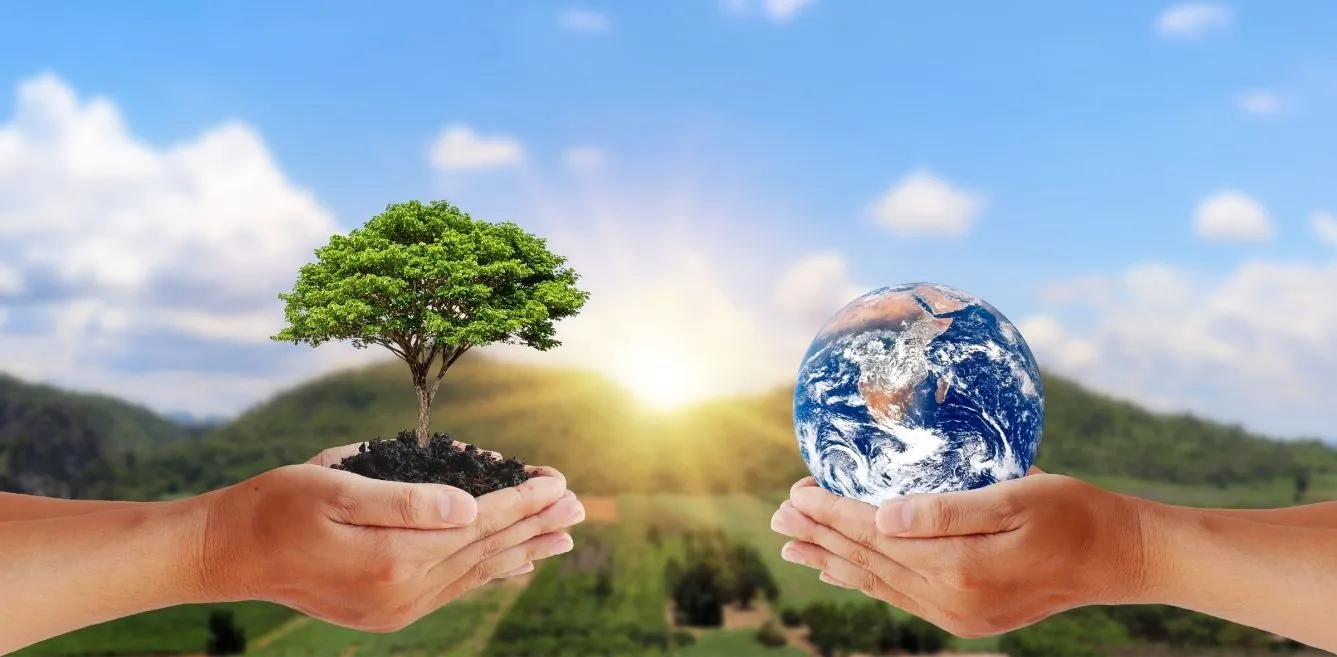
- 23 Apr 2024
Why is it in the News?
The European Court of Human Rights found Switzerland guilty of violating the rights of women from KlimaSeniorinnen, stating that the government's emission control efforts were insufficient, failing to protect women from climate change impacts.
Context:
- Courts worldwide are increasingly tasked with addressing the nexus between climate change and human rights, as evidenced by significant rulings such as those from the European Court of Human Rights in Switzerland and the Supreme Court of India.
- These landmark decisions highlight the imperative of acknowledging climate change as a human rights issue and establishing crucial benchmarks for legal and policy responses to mitigate its detrimental effects on people and societies.
Legal Acknowledgment of Climate Change's Human Rights Impacts:
- Recent rulings by the European Court of Human Rights against the Government of Switzerland and the Supreme Court of India have underscored the failure to safeguard vulnerable populations from the effects of climate change.
- The European Court's decision highlighted the government's neglect in protecting elderly women from climate-related harm, while the Indian Supreme Court affirmed citizens' entitlement to freedom from adverse climate effects under constitutional guarantees.
- Citing Articles 14 (equality before the law) and 21 (right to life and personal liberty) of the Indian Constitution, the Supreme Court emphasized individuals' right 'to be free from the adverse impacts of climate change.'
- These legal judgments signify a significant step towards acknowledging climate change as a pivotal human rights concern.
The Escalating Human Rights Risks of the Global Climate Crisis:
- The global climate crisis presents an imminent threat to human rights, imperiling individuals and communities worldwide.
- The latest State of the Global Climate Report from the World Meteorological Organization presents compelling evidence of the intensifying impacts of climate change.
- In 2023, numerous climate indicators soared to unprecedented levels, marking it as the hottest year on record.
- This unparalleled warmth coincided with concerning trends such as heightened ocean heat accumulation, rising sea levels, diminishing Antarctic sea ice, and accelerated glacier retreat.
- These indicators underscore the severe strain on our planet, with profound implications for human welfare.
India's Climate Action and Vulnerability:
- Progress Amid Persistent Vulnerability: Despite notable advancements in climate action, India, among the world's fastest-growing economies, continues to confront significant vulnerability to climate change.
- Having met two of its Nationally Determined Contribution (NDC) targets—reducing emissions intensity by 33% to 35% and achieving 40% cumulative non-fossil fuel electricity capacity—well ahead of schedule, India demonstrates proactive measures.
- Nevertheless, the nation remains highly susceptible to climate-related adversities.
- Population Concentration in Disaster-Prone Areas: A primary concern is India's demographic distribution, with over 80% of its populace residing in regions prone to climate-induced calamities like floods, cyclones, droughts, and heatwaves.
- These events not only disrupt lives but also exacerbate existing socio-economic disparities, disproportionately impacting vulnerable groups such as small-scale farmers, rural communities, and marginalized populations.
- Intersecting Challenges of Climate Change: Climate change intersects with broader socio-economic and environmental issues, compounding their repercussions.
- Rapid urbanization and haphazard development intensify urban vulnerability to climate-driven disasters like flooding and landslides.
Frameworks to Strengthen India's Climate Action:
- Embracing Comprehensive Legislation: India's climate governance could benefit from the adoption of a comprehensive regulatory framework dedicated to climate change.
- This legislation would offer a unified structure for addressing diverse climate-related aspects, spanning mitigation, adaptation, finance, and capacity-building.
- By enshrining climate objectives, targets, and strategies in law, such a framework can furnish legal clarity and consistency, guiding sustained planning and investment.
- Insights from Global Climate Laws: Research from the London School of Economics and Political Science examined climate framework laws in 60 nations, spotlighting their pivotal role in shaping national climate agendas.
- Countries like Germany, Ireland, New Zealand, Finland, South Korea, South Africa, and the Philippines have instituted robust climate legislation surpassing mere compliance with international obligations.
- These laws have facilitated public resource mobilization, bolstered climate action capabilities, and fostered inter-sectoral cooperation.
Additional Measures for Enhanced Climate Governance in India:
- Integrated Climate Policies: India's climate strategies should embrace an integrated approach, embedding climate considerations into broader development frameworks and decision-making processes.
- This entails weaving climate adaptation and mitigation efforts throughout key sectors like agriculture, water management, energy, transportation, and urban development to foster a cohesive response to climate challenges.
- Localized Solutions and Cross-Sector Collaboration: Tailored, localized climate actions, coupled with collaborative efforts across sectors, are vital for addressing the diverse and context-specific impacts of climate change.
- Governments can craft targeted strategies to bolster resilience, mitigate risks, and advance sustainable development goals by engaging local stakeholders and fostering partnerships across sectors.
- Harmonizing Climate and Sustainable Development Goals: Localized climate initiatives often align with broader Sustainable Development Goals (SDGs), such as poverty eradication, food security, access to clean water, and gender equity.
- Integrating climate considerations into local SDG agendas enables governments to leverage synergies, optimize resource use, and fortify community resilience and sustainability.
- Empowerment of Civil Society: Civil society organizations (CSOs) play a pivotal role in advocating for climate action, environmental equity, and governmental accountability.
- Empowering CSOs and fostering rights-based discourse on climate change are vital for fostering inclusive decision-making, transparency, and environmental justice.
- Fostering Inclusivity and Representation: Promoting diversity and inclusivity within civil society is imperative to ensure the voices and perspectives of marginalized communities are heard and heeded in climate policymaking.
- CSOs should aim to represent the interests of various stakeholders, including women, indigenous populations, youth, persons with disabilities, and other marginalized groups, in climate governance.
- Advancing Rights-Centric Discourse: A rights-based approach to climate action acknowledges that climate change disproportionately impacts vulnerable communities, infringing upon their basic human rights to life, health, food, water, and livelihoods.
- By framing climate change as a human rights issue, CSOs can advocate for policies that prioritize the needs of affected communities and champion environmental justice.
Conclusion
The alignment of legal rulings, scientific findings, and policy mandates emphasizes the pressing imperative to confront climate change as a human rights emergency.
By acknowledging the inseparable link between environmental health and human welfare, nations can pave the way toward climate resilience and equity.
Empowering communities, fortifying legal structures, and promoting cross-sectoral cooperation stand as pivotal measures in realizing a future liberated from the detrimental effects of climate change.
Climate Crisis is Not Gender Neutral
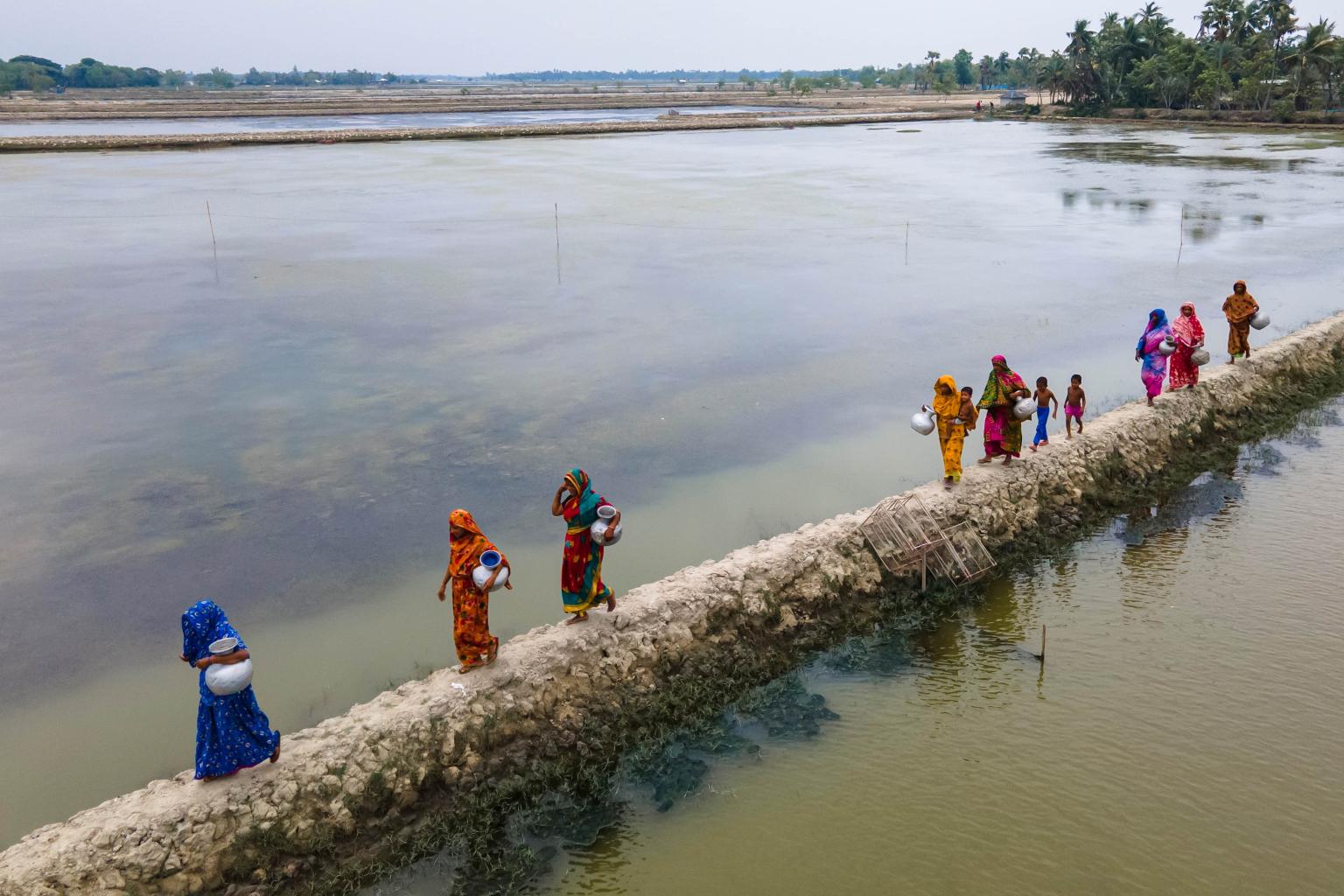
- 10 Apr 2024
Why is it in the News?
The climate crisis is far from “gender neutral” as women and men are affected differently by weather and climate and therefore need gender-sensitive information and services.
Context:
- As the climate crisis intensifies, its disproportionate impact on women and girls becomes more evident, particularly in poverty-stricken regions.
- This calls for a critical examination of the gender dimensions of climate change, recognizing women's increased vulnerabilities and the importance of incorporating gender perspectives in climate action strategies.
- By doing so, we can develop effective solutions that address the unique challenges faced by women, ensuring a more equitable and sustainable approach to climate change mitigation and adaptation.
How Does Climate Change Impact Women?
- Rural Livelihood Dependence on Agriculture: In many regions, particularly rural India, women play a central role in agricultural activities, forming the backbone of their communities' livelihoods.
- However, the effects of climate change, such as erratic rainfall, droughts, and floods, pose significant threats to crop yields, directly impacting food security and income for these women.
- Compounded by limited access to essential resources like land, credit, and technology, women face heightened vulnerabilities in navigating climate-related risks.
- Health Risks Amplified by Climate Hazards: Women's health is uniquely susceptible to the challenges posed by climate change.
- For instance, prolonged heatwaves increase the risk of complications during pregnancy, including preterm birth and eclampsia.
- Moreover, exposure to indoor and outdoor air pollution exacerbates respiratory and cardiovascular diseases among women and unborn children, compromising their well-being.
- Gender Dynamics in Extreme Weather Events: The rise in the frequency of extreme weather events, such as floods, droughts, and cyclones, has profound implications, particularly for vulnerable populations.
- Reports highlight that a significant portion of Indian districts are susceptible to such disasters, placing women and children at heightened risk.
- Emerging studies underscore a concerning correlation between these natural calamities and incidents of gender-based violence against women.
- Additionally, disruptions in water access due to climate-induced changes affect women's ability to engage in productive activities and access healthcare, intensifying their workload and compromising their overall welfare.
- Nutritional Challenges and Early Marriage: In regions prone to drought, women and girls face heightened risks of undernutrition due to food insecurity.
- Data indicates that women residing in these areas are more likely to experience underweight conditions and are at a higher risk of entering early marriages, perpetuating cycles of poverty and gender inequality.
How to Empower Women in Climate Action?
- Rich Tradition of Environmental Stewardship: Throughout history, women have been integral to environmental conservation efforts.
- Across various communities, they serve as primary custodians of natural resources, managing land, water, and forests with a deep-rooted understanding of sustainability.
- Their traditional knowledge and practices are invaluable assets for fostering biodiversity conservation and promoting climate-resilient agricultural techniques.
- Boosting Agricultural Productivity and Food Security: Providing women farmers with equitable access to resources such as land, credit, and agricultural inputs unleashes their potential to enhance agricultural productivity and adapt to climate change.
- Research indicates that closing the gender gap in agriculture could significantly increase crop yields and bolster food security.
- Women's innate connection to smallholder farming systems enables them to innovate with cost-effective, environmentally friendly farming methods, thereby fostering resilience in agricultural practices.
- Key Players in Local Adaptation Strategies: Women are pivotal to the success of community-based adaptation efforts, which prioritize building resilience to climate change at the grassroots level.
- Through women's groups and collectives like Self-Help Groups (SHGs) and Farmer Producer Organizations (FPOs), communities mobilize, share knowledge, and implement adaptation measures.
- These grassroots initiatives empower women to advocate for their rights in decision-making processes concerning natural resource management and climate resilience.
- Inspiring Role Models and Catalysts for Change: Women leaders in climate action serve as inspirations and role models, paving the way for future generations of environmentalists and activists.
- Their prominence in climate solutions not only challenges gender norms but also encourages greater participation of women and girls in STEM fields and environmental leadership roles.
- By highlighting women's contributions to climate action, these role models empower others to pursue careers and opportunities in climate science, policy, and advocacy, fostering a more inclusive and impactful approach to addressing climate change.
Action Needed to Address the Gender Implications of Climate Change:
- Immediate Protection Against Health Risks: Swift action is imperative to safeguard vulnerable populations, such as pregnant women, outdoor laborers, children, and the elderly, from health risks exacerbated by extreme weather events like heat waves.
- Local authorities must develop and implement comprehensive heatwave response plans, incorporating early warning systems, establishing cooling centers, and adapting work and school schedules to mitigate heat-related illnesses and fatalities.
- Improved Access to Safe Drinking Water: Climate-induced disruptions to water sources escalate water scarcity and endanger public health.
- Immediate interventions are essential to enhance access to safe drinking water, particularly for women and girls responsible for water collection in many communities.
- Investments in water infrastructure, rainwater harvesting systems, and water purification technologies are vital to alleviate the impacts of water scarcity on vulnerable populations.
- Climate-Resilient Urban Planning: Urban areas face escalating vulnerabilities to climate-related hazards, including heatwaves, flooding, and air pollution.
- Urban planning strategies emphasizing green infrastructure—such as parks, green roofs, and tree-lined streets—can mitigate the urban heat island effect and minimize exposure to extreme temperatures.
- Moreover, measures to enhance air quality, like reducing vehicular emissions and promoting clean energy technologies, are crucial for safeguarding public health, particularly for women and children susceptible to respiratory and cardiovascular diseases.
- Community-Centered Adaptation Efforts: Community-based adaptation initiatives, engaging local communities, including women's groups and grassroots organizations, are pivotal in bolstering resilience to climate change at the grassroots level.
- These initiatives should prioritize the needs and aspirations of women and marginalized groups, empowering them in decision-making processes regarding adaptation planning and implementation.
- Investments in building the capacity of local institutions and community leaders can amplify the efficacy and sustainability of adaptation endeavors.
- Gender-Inclusive Climate Policies: National and sub-national climate policies must integrate gender-responsive approaches tailored to the distinct needs and priorities of women and girls.
- Recognizing women as agents of change and empowering their participation in climate decision-making at all levels is essential.
- Gender mainstreaming in climate policies ensures inclusivity, equity, and effectiveness in tackling the underlying drivers of vulnerability and inequality.
Conclusion
The disparities and vulnerabilities experienced by women and girls underscore the urgent need for inclusive and gender-responsive strategies in climate adaptation and mitigation endeavors.
By empowering women, we not only bolster resilience but also unlock innovative solutions crucial for combating the climate crisis. Thus, the integration of gender perspectives into climate action plans is imperative for forging a sustainable and equitable future for all
Heat Waves and its Impacts in India

- 02 Apr 2024
Why is it in the News?
The India Meteorological Department (IMD) has forecast a harsh and arid summer over a majority of regions of the country during April- June, with a high probability of heatwave episodes lasting as long as 10 to 20 days during the period.
Recent Prediction by India Meteorological Department (IMD):
- Extreme Heat Outlook: India is anticipated to face extreme heat from April to June, with central and western regions likely to be most affected.
- Expectations of 10 to 20 heatwave days across the country, exceed the normal range of four to eight days.
- Regions including Gujarat, central Maharashtra, north Karnataka, Rajasthan, Madhya Pradesh, Odisha, north Chhattisgarh, and Andhra Pradesh are forecasted to experience severe heatwaves in April.
- Pre-Monsoon Rainfall Performance: Below-average pre-monsoon rainfall is expected this month, particularly impacting coastal, eastern, and southern India.
- El Nino Conditions: El Nino conditions, marked by abnormal sea surface warming in the equatorial Pacific Ocean since last June, have the potential to reduce rainfall and increase temperatures, both locally in India and globally.
- Despite El Nino conditions easing after peaking in December, persistent warm conditions continue to elevate global temperatures.
- Recent Weather Conditions: February and March witnessed hotter-than-normal weather in southern India.
- Heatwave conditions were reported in Maharashtra, northern Karnataka, Saurashtra-Kutch, and parts of Rajasthan during late March.
- Maximum temperatures soared to 42.6 degrees Celsius in areas such as Akola in Maharashtra and Phalodi in Rajasthan.
What are Heat Waves?
- Heatwaves entail prolonged periods of exceptionally hot weather, posing adverse effects on human health, the environment, and the economy.
- Given India's tropical climate, the nation is especially susceptible to heat waves, which have witnessed increased frequency and intensity in recent times.
What is the Criterion for Declaring a Heat Wave?
For Plains and Hilly Regions:
- Heatwave is recognized when the maximum temperature of a station reaches at least 40°C or higher for Plains and at least 30°C or higher for Hilly regions.
- Determined based on Departure from Normal Heat Wave:
- Departure from normal temperature ranges from 4.50°C to 6.40°C, with anything exceeding 6.40°C classified as a Severe Heat Wave.
- Alternatively, based on Actual Maximum Temperature Heat Wave:
- A heat wave is declared when the actual maximum temperature equals or exceeds 45°C, while a Severe Heat Wave is acknowledged if the actual maximum temperature equals or exceeds 47°C.
- Declaration occurs when the above criteria are met in at least 2 stations within a Meteorological subdivision for a minimum of two consecutive days, with the declaration taking effect on the second day.
For Coastal Areas:
- A heat wave may be identified when the maximum temperature departure from normal is 4.50°C or more, provided the actual maximum temperature registers at 37°C or higher.
Fatality Risk:
- While high temperatures alone may not be lethal, it's the conjunction of elevated temperatures and humidity, known as the wet bulb temperature, that renders heatwaves perilous.
- Increased moisture levels impede sweat evaporation and hinder body cooling mechanisms, leading to a rapid rise in internal body temperature, frequently resulting in fatal outcomes.
What are the Causes of Heatwaves?
- Global Warming: A primary factor driving heatwaves in India is global warming, a consequence of sustained increases in Earth's average temperature linked to human activities like fossil fuel combustion, deforestation, and industrial operations.
- Elevated temperatures and altered weather patterns can stem from this phenomenon.
- Rapid Urbanization: Rapid urban expansion and the proliferation of urban landscapes contribute to the "urban heat island effect."
- Urban areas, dense with population, structures, and concrete surfaces, absorb and retain heat, intensifying temperatures, particularly during heatwaves.
- El Nino Influence: El Nino events, characterized by Pacific Ocean warming, exert global climatic impacts, triggering shifts in temperature, precipitation, and wind patterns.
- The conclusion of a strong La Nina phase in the equatorial Pacific Ocean and the untimely onset of an El Nino event are anticipated factors contributing to the exceptionally hot forecast for the summer of 2023.
What are the Impacts?
- Health Effects: Swift escalation in heat exposure can disrupt the body's ability to regulate temperature, resulting in various ailments such as heat cramps, heat exhaustion, heatstroke, and hyperthermia, potentially leading to fatalities or hospitalizations.
- Water Resources Impact: Heatwaves exacerbate water scarcity issues in India, causing water bodies to dry up, diminishing water availability for agriculture and domestic use, and intensifying competition for water resources, fostering conflicts and influencing irrigation practices and water-reliant industries.
- Energy Impact: Elevated temperatures heighten demand for cooling, straining power grids and heightening the risk of blackouts, disrupting economic operations, reducing productivity, and adversely affecting vulnerable communities without reliable access to cooling amenities during heatwaves.
How to Mitigate Extreme Heat Wave Events?
- To mitigate the adverse effects of heat waves and climate change, a comprehensive action plan must be implemented at various levels:
- Heat Wave Action Plan: Develop a long-term plan to protect human lives, livestock, and wildlife by prioritizing effective adaptation strategies and robust disaster management policies.
- Ensure proper implementation of the Sendai Framework for Disaster Risk Reduction, with governments taking the lead and engaging multiple stakeholders.
- Implementing Climate Action Plans: Commit to the National Action Plan for Climate Change (NAPCC) for inclusive growth and ecological sustainability.
- Emphasize nature-based solutions that uphold ethical standards and promote intergenerational justice.
- Sustainable Cooling: Adopt passive cooling technology to create naturally ventilated buildings, reducing the urban heat island effect in residential and commercial areas.
- Consider adapting ancient Indian building designs, as recommended by the Intergovernmental Panel on Climate Change (IPCC), to modern facilities.
- Heatwave Mitigation Plans: Implement measures to prevent heat-related fatalities, including providing access to water, oral rehydration solutions, shade in public spaces, flexible working hours, and accommodations for outdoor workers.
- Vigilant local administration and oversight by higher authorities are key to successful implementation.
- By implementing these strategies and fostering collaboration among stakeholders, we can create a more resilient future that effectively addresses the challenges posed by heat waves and climate change.
Indian Meteorological Department (IMD):
- India Meteorological Department is the country's National Meteorological Service.
- It deals with all matters relating to meteorology, seismology, and associated subjects.
- IMD is headquartered in Delhi and operates hundreds of observation stations across India and Antarctica.
- IMD units such as Forecasting Offices, Agrometeorological Advisory Service Centers, Hydro-meteorological Offices, Flood Meteorological Offices, Area Cyclone Warning Centers, and Cyclone Warning Centers are usually co-located with various observatories or meteorological centers.
- IMD is also one of the six Regional Specialized Meteorological Centres of the World Meteorological Organization.
- It is responsible for forecasting, naming, and distributing warnings for tropical cyclones in the Northern Indian Ocean region, including the Straits of Malacca, the Bay of Bengal, the Arabian Sea, and the Persian Gulf.
- Nodal Ministry: Ministry of Earth Sciences of the Indian Government
Navigating the Global Waterscape, and Its Challenges
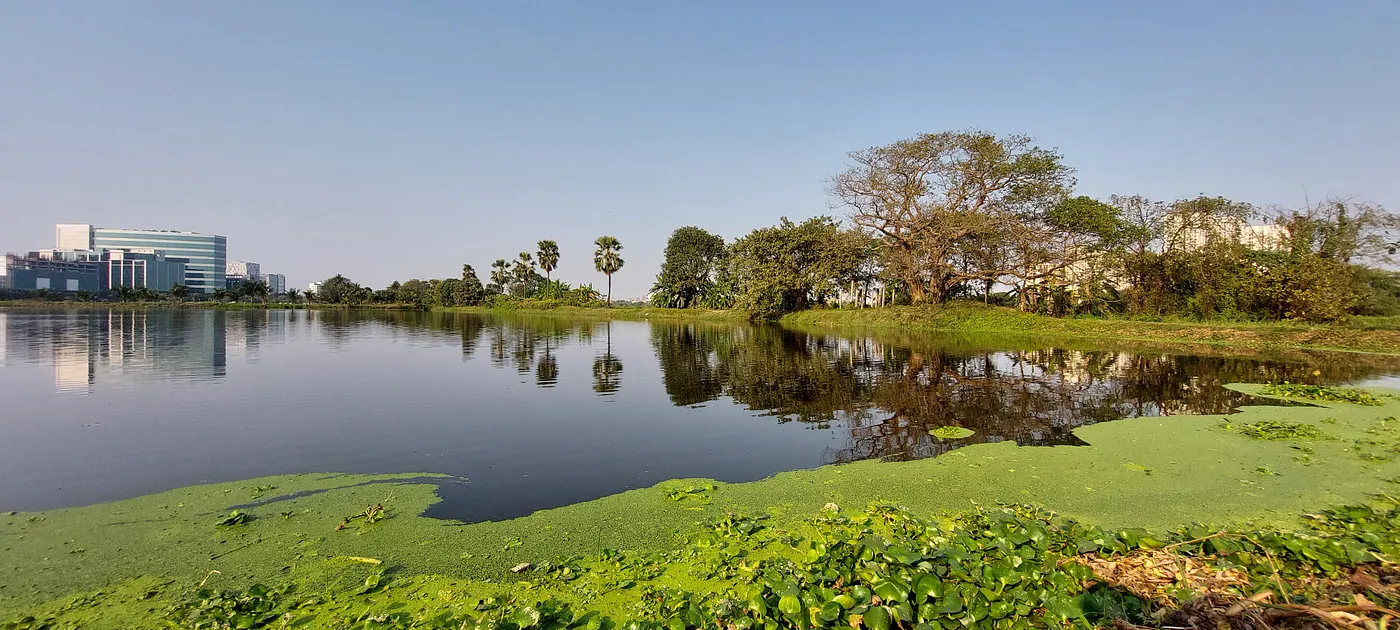
- 22 Mar 2024
Why is it in the News?
In the context of climate change-related pressures, the world also needs to foster improved cooperation over water-sharing.
Context:
- The global water crisis remains a critical issue, with roughly two billion people lacking access to clean water, threatening individual and collective well-being.
- Water has been a determining factor in civilizations' prosperity and decline throughout history.
- Ancient Mesopotamian cities experienced conflicts over fertile land and water resources, illustrating the age-old struggle for water.
- As the 31st World Water Day approaches in 2024, themed "Leveraging Water for Peace," the United Nations emphasizes the significance of water diplomacy to tackle contemporary water challenges and secure a sustainable future for all.
Water Diplomacy in a Time of Extremities:
- Encouraging Collaborative Governance: Water diplomacy underscores the necessity of collaborative governance mechanisms to effectively tackle shared water challenges.
- By uniting relevant stakeholders—governments, local communities, NGOs, and international agencies—collaborative governance frameworks foster dialogue, information exchange, and joint decision-making.
- These mechanisms pave the way for sustainable water management policies and strategies that prioritize the needs and interests of all involved parties.
- Ensuring Fair Water Allocation: At the core of water diplomacy lies the principle of equitable water allocation among riparian states.
- Acknowledging that water resources transcend political boundaries, water diplomacy advocates for fair distribution, considering the needs, rights, and vulnerabilities of all stakeholders.
- Through negotiated agreements and treaties, riparian states can establish frameworks for sharing water resources, managing competing demands, and peacefully resolving disputes.
- Promoting Regional Stability and Peace: Effective water diplomacy contributes to regional stability and peace by mitigating conflicts over shared water resources.
- By fostering cooperation and understanding among neighboring states, water diplomacy builds trust, enhances security, and reduces tensions stemming from water-related disputes.
- Additionally, collaborative water management initiatives foster cross-border cooperation, economic integration, and diplomatic relations, bolstering broader efforts to uphold peace and stability in conflict-prone regions.
- Embracing Inclusive Approaches: Inclusive water diplomacy involves engaging a diverse array of stakeholders, including indigenous communities, civil society organizations, academia, and the private sector.
- Recognizing the importance of marginalized groups' contributions and perspectives, inclusive approaches promote social equity and transparency in decision-making processes.
- By integrating local knowledge, cultural practices, and community priorities, inclusive water diplomacy enhances the legitimacy and efficacy of governance frameworks.
- Preventing and Resolving Conflicts: Water diplomacy plays a pivotal role in preventing and resolving conflicts arising from competing water interests.
- Through proactive diplomacy, early warning systems, and confidence-building measures, riparian states can address potential sources of tension and defuse conflicts before they escalate.
- Moreover, mechanisms for peaceful dispute resolution, such as arbitration and mediation, enable states to resolve water-related disputes through dialogue and negotiation, averting coercive or confrontational measures.
Strategic Approaches for Tackling Rural Water Challenges in India:
- Enhancing Infrastructure: A primary strategy involves developing water infrastructure like wells, hand pumps, boreholes, and piped systems to improve access to safe water and sanitation facilities in rural areas.
- Investment in constructing and maintaining such infrastructure can reduce waterborne diseases, leading to better health outcomes.
- Encouraging Community Engagement: Engaging local communities in planning, implementing, and managing water projects is crucial for their sustainability and success.
- Empowering rural residents through participatory water management committees and user associations can promote ownership of water resources, efficient practices, and conflict resolution.
- Conservation and Management Practices: Promoting conservation and management practices is vital for maximizing water efficiency in rural areas.
- Techniques like rainwater harvesting, groundwater recharge, watershed management, and soil moisture conservation can reduce reliance on unpredictable water sources and build climate resilience.
- Incorporating Technological Innovations: Leveraging technology can significantly improve water access and management in rural areas.
- Solar-powered pumps, drip irrigation systems, and water-efficient technologies can enhance agricultural productivity, while monitoring applications and remote sensing can enable real-time resource management.
- Policy Support and Interventions: Government support is essential in addressing rural water needs through adequate funding, regulatory frameworks for equitable water distribution, and legislation to protect water resources and promote sustainable practices.
- Policy coherence across the agriculture, health, and environment sectors is crucial for tackling the interconnectedness of water, food security, and rural development.
Addressing Transboundary Water Challenges:
- Highlighting the Significance of Transboundary Waters: The report underscores the prominence of transboundary waters, noting that a substantial portion of the world's freshwater resources, including those in India, are shared across borders.
- India's extensive landmass boasts a network of long rivers, vital not only for its own needs but also shared with neighboring countries.
- However, the South Asian region has witnessed a significant deterioration in water quality in recent years, particularly in rivers like the Meghna, Brahmaputra, Ganga, and Indus, as highlighted in the 2024 report.
- The Need for Sophisticated Cross-Border Water Governance: Addressing these challenges requires a sophisticated approach to cross-border water governance, promoting effective and equitable allocation of water resources among nations that share them.
- It is imperative to develop robust mechanisms for cooperation and coordination to manage shared waters sustainably.
- Global Perspective on Transboundary Cooperation: According to a 2021 UNESCO progress report on Sustainable Development Goal indicator 6.5.2, titled "Progress on transboundary water cooperation," out of UNESCO's 194 member states and 12 associate members, 153 countries are classified as water-sharing nations.
- Remarkably, transboundary waters account for 60% of the world's freshwater flows.
- However, only 24 of these 153 countries have achieved a 100% cooperation agreement on their shared waters, indicating the pressing need for enhanced collaboration.
- Ensuring Collective Well-being and Peace: While significant progress has been made in fostering peace over time, the scarcity of freshwater poses a threat to our collective well-being and peace.
- This issue is not only crucial for achieving the 2030 Agenda and Sustainable Development Goals (SDGs) but also for maintaining stability and harmony among nations.
- Effective transboundary cooperation in the sustainable management of water resources is essential to realize benefits across various sectors, including health, food and energy security, disaster resilience, education, improved standards of living, employment, economic development, and the preservation of ecosystem services.
Conclusion
As the global struggle for clean water access continues for approximately two billion people, the ever-increasing demand for this precious resource directly impacts our collective well-being and peace. In order to build a sustainable future, we must prioritize water conservation efforts that transcend political boundaries, fostering regional cooperation and stability. By recognizing the urgency of this challenge, we can work together to ensure a secure and equitable water supply for generations to come.
Green jobs and the problem of gender disparity
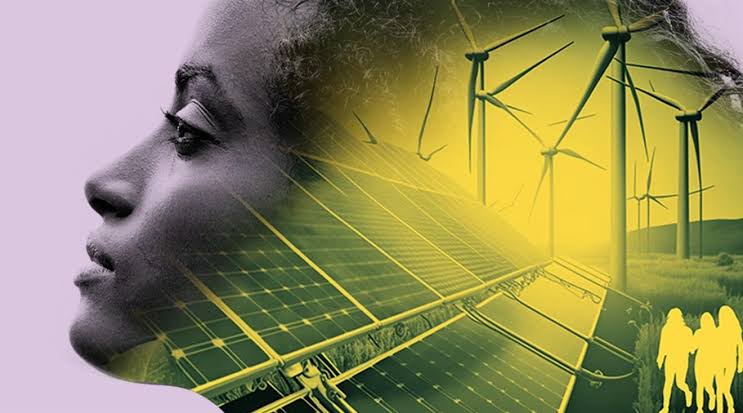
- 06 Mar 2024
Why is it in the News?
Increasing women’s representation in green jobs will lead to benefits such as boosting a low-carbon and environmentally sustainable economy
Context:
- The worldwide movement towards low-carbon development presents India with a distinctive opportunity for progress.
- Nevertheless, this transition brings forth a gender disparity challenge, as men tend to transition to green jobs more rapidly than women.
- Hence, it's crucial to delve into the gender aspects of India's green transition, highlighting the imperative for women's empowerment and gender equality in climate initiatives.
What are Green Jobs?
- Green jobs represent a category of employment directly benefiting the planet and contributing to overall environmental well-being.
- These roles are geared towards mitigating the negative environmental impact of various economic sectors and advancing the creation of a low-carbon economy.
- Occupations involving renewable energy, resource conservation, and the promotion of energy-efficient practices fall under this umbrella.
- The International Labour Organization characterizes green jobs as 'decent jobs that contribute to the preservation or restoration of the environment.'
- They encompass diverse sectors such as manufacturing, construction, renewable energy, energy efficiency, and automobiles, historically characterized by lower female representation.
Gender Disparity in Green Jobs:
- Globally, men tend to transition to green jobs at a faster pace than women.
- Despite India's significant increase in renewable energy capacity by 250% between 2015 and 2021, women constitute only 11% of workers in the solar rooftop sector.
- The Annual Survey of Industries 2019-20 reveals that women workers are predominantly concentrated in industries like apparel, textile, leather, food, and tobacco.
- According to a Confederation of Indian Industry (CII) 2019 report, men make up 85% of the workforce in sectors such as infrastructure, transport, construction, and manufacturing.
- A 2023 study by the Skill Council for Green Jobs indicated that 85% of green skills training was provided to men, with over 90% of women expressing belief that social norms hinder their participation in such training.
- Restrictive social norms contributing to this disparity include perceptions that women are unsuitable for certain technical roles, safety concerns, lower representation in science, technology, engineering, and mathematics (STEM) subjects, and familial constraints.
Advantages of Women's Engagement in Green Jobs:
- Addressing Gender Bias in the Labour Market: Increased representation of women in green jobs acts as a potent remedy to entrenched gender biases in the labor market.
- By entering traditionally male-dominated sectors like manufacturing, construction, and renewable energy, women challenge stereotypes and reshape societal perceptions of gender roles.
- Expanded Economic Opportunities: Women's greater involvement in green jobs opens up expanded economic avenues for them.
- Participation in sectors such as renewable energy and energy efficiency enables women to access high-growth industries, fostering both economic growth and personal financial stability.
- Beyond economic benefits, engagement in green jobs offers opportunities for women's advancement in technical and social spheres, exposing them to innovative technologies, sustainable practices, and networking opportunities.
- Empowerment of Women's Agency: The transition to green jobs empowers women by granting them agency over their economic destinies.
- In roles contributing to environmental preservation or restoration, women find alignment with a broader sense of purpose, fostering a deeper connection to their work and its societal impact.
- Contribution to Long-Term Gender Empowerment: Participation in green jobs extends beyond immediate economic gains, contributing to the enduring empowerment of women.
- By breaking into historically imbalanced sectors, women pave the way for future generations, inspiring young girls to pursue careers in STEM fields.
- Promotion of Environmental Stewardship: Women's involvement in green jobs resonates with their recognized role as custodians of the environment.
- With a nuanced understanding of the interconnectedness of social and ecological systems, women offer unique perspectives to the development and implementation of sustainable practices within green industries.
Way Forward:
- Addressing Data Gaps: Rectifying the lack of data is imperative to understand the landscape of women's participation in green jobs in India.
- Initiatives should focus on mapping emerging areas for green growth and collecting sex-disaggregated data on green jobs to enhance women's engagement.
- Conducting gender analysis, gathering gender statistics through periodic labor force surveys, and mobilizing additional resources can shed light on the present and future impact of low-carbon transitions on women workers and entrepreneurs.
- Supporting Women Entrepreneurs: Gender-targeted financial policies and products tailored to the needs of women entrepreneurs can catalyze their entry into the green transition market.
- Measures such as collateral-free lending, financial literacy training, and establishing supportive networks are crucial to unlock their potential.
- Developing appropriate tools to assess creditworthiness, facilitate loan disbursement, and reduce operational costs for women-owned businesses is essential.
- Promoting a Gender-Just Transition: A comprehensive strategy for a gender-just transition encompasses employment, social protection, reduction of care work burden, and skill development.
- Collaboration among government, private sectors, and stakeholders is essential to harness innovation, technology, and finance for women entrepreneurs and workers.
- Businesses must prioritize gender justice to mitigate barriers and promote equitable job opportunities for a fair transition.
Conclusion
As India navigates its green transition, prioritizing women's empowerment and gender equity in climate actions is essential for unlocking the co-benefits of a low-carbon and environmentally sustainable economy. Bridging the gender gap in green jobs requires concerted efforts to address social norms, collect gender-disaggregated data, and implement inclusive policies. This is not only an economic imperative but a crucial step towards building a socially equitable and inclusive future for all.
India's Journey to Net-Zero Amidst Mineral Shortages and Technological Challenges
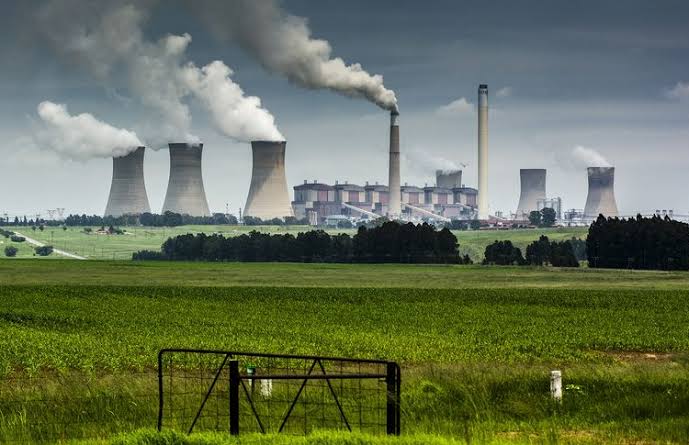
- 05 Mar 2024
Why is it in the News?
By 2030, India wants to set up 500 GW of non-fossil fuel power generating capacity but the problem is that the availability of the minerals is not enough. One needs to process it and manufacture the final product which also means access to technology.
Background:
- As the world shifts towards decarbonization and faces growing demand for critical minerals, governments worldwide are strategically securing access to these vital resources.
- In alignment with this trend, the Indian government has amended mining laws to encourage private sector involvement in the extraction and processing of critical minerals.
Importance of Critical Minerals:
- Driving Decarbonization and Clean Energy Technologies: Critical minerals are pivotal for clean energy technologies such as solar PV plants, wind farms, and electric vehicles, essential for global decarbonization efforts.
- According to the International Energy Agency (IEA), a substantial portion of minerals like copper, rare earths, nickel, cobalt, and lithium will be crucial for meeting Paris Agreement targets.
- Transforming the Transportation Sector: Electric vehicles (EVs) rely heavily on critical minerals like lithium, cobalt, and nickel for their battery production.
- As countries shift towards EV adoption, the demand for these minerals is expected to soar, driving sustainable transportation initiatives.
- Essential in Consumer Electronics: Critical minerals are vital for producing consumer electronics such as smartphones, laptops, and tablets.
- Rare earth elements and other minerals enable the miniaturization and enhanced performance of electronic devices.
- Supporting the Construction Industry: Critical minerals contribute to the production of high-strength alloys, cement, and other building materials in the construction sector.
- These minerals enhance the durability and efficiency of construction materials, promoting sustainability in infrastructure projects.
- Ensuring Defence and National Security: In the defense sector, critical minerals are indispensable for advanced weaponry and communication systems.
- Securing a stable supply of these minerals is critical for maintaining national security and technological superiority.
- Vital for Fertilizers and Agriculture: Minerals like phosphorus and potassium are essential components in fertilizers, crucial for enhancing crop yields and ensuring global food security.
- Crucial for Industrial Magnets: Neodymium, praseodymium, and dysprosium, critical minerals, are crucial for manufacturing magnets used in various industries.
- These magnets are integral components in technologies ranging from electric motors to medical devices.
Geopolitical Dynamics of Critical Minerals and Global Ramifications:
- Economic Dynamics: The geographical concentration of critical mineral resources in select countries like Australia, China, the Democratic Republic of Congo (DRC), Indonesia, and Chile fosters economic dependencies.
- Nations with substantial reserves enjoy advantages in revenue generation, job creation, and overall economic development, potentially leading to global economic disparities.
- Geopolitical Power Play: The strategic significance of critical minerals turns their extraction and processing into geopolitical instruments, enabling nations to wield influence on the global stage.
- China, notably, has leveraged its dominance in rare earths to exert political pressure, exemplified by restrictions on exports to countries such as the US and Japan.
- China's control over critical minerals, coupled with its monopolized processing capacity, carries significant geopolitical implications, prompting international collaborations like the US-led Minerals Security Partnership (MSP) to secure supply chains and reduce dependence on authoritarian regimes.
- Supply Chain Vulnerability: The concentration of critical mineral resources in specific regions raises concerns about the vulnerability of global supply chains.
- Political instability, trade conflicts, or other geopolitical events in major producing nations can disrupt the supply of critical minerals, adversely affecting industries reliant on them.
India's Objectives and Hurdles in Acquiring Critical Minerals:
- Pursuit of Decarbonization Goals and Energy Transition: India has outlined ambitious objectives for decarbonization, aiming for net-zero emissions by 2070 and establishing 500 GW of non-fossil fuel power generation capacity by 2030.
- Embracing renewable energy sources, electric vehicles, and sustainable practices underscores India's dedication to combatting climate change.
- Heavy Reliance on Imports: Despite possessing identified reserves, India heavily depends on imports to meet its demand for critical minerals.
- This import dependency presents significant challenges, exposing the nation to global market fluctuations, supply chain disruptions, and potential geopolitical tensions.
- Strategic Agreements for Exploration: Acknowledging the necessity to reduce import reliance, India has forged strategic agreements, such as the one with Australia, to jointly explore critical minerals like lithium and cobalt.
- Collaborations with resource-rich nations aim to secure access to raw materials and diversify sources beyond traditional suppliers.
- Lack of Domestic Processing Capacity: Identifying critical minerals marks only the initial step; subsequent processing and manufacturing require advanced technology and infrastructure.
- India encounters challenges in building domestic processing capacity, contributing to an extended gestation period before achieving self-reliance.
- Apart from raw material availability, accessing advanced processing technology remains crucial, emphasizing the importance of technology transfer and collaborative ventures with proficient countries.
- Participation in International Collaborations: India's engagement in the US-led MSP illustrates its dedication to fostering strategic partnerships for securing the critical minerals supply chain.
- The MSP encompasses countries with critical mineral deposits and access to processing technology, fostering a collective endeavor to surmount challenges.
Noteworthy Actions Undertaken by the Indian Government:
- Identification of Critical Minerals: In July 2023, India took a significant stride by identifying a list of 30 critical minerals, distinct from rare earths.
- Each mineral was selected based on criteria such as disruption potential, substitutability, cross-cutting usage, import reliance, and recycling rates.
- The identified minerals are predominantly concentrated in states and union territories, including Bihar, Gujarat, Jharkhand, Odisha, Tamil Nadu, Uttar Pradesh, Chhattisgarh, and Jammu and Kashmir.
- Amendment of Existing Mining Laws: Subsequently, in November 2023, the Indian government amended existing mining laws to facilitate private sector participation in the auction of 20 blocks containing critical minerals and rare earths.
- This amendment signifies a notable shift in India's mineral sector, unlocking opportunities for private enterprises to engage in the extraction and processing of these vital resources.
Conclusion
There is a mounting concern that the limited access to critical minerals could pose a substantial obstacle to India's ambitious journey towards decarbonization. The achievement of decarbonization objectives hinges on surmounting challenges associated with import reliance, processing capabilities, and technological advancements.
An expansive land management policy is overdue

- 27 Feb 2024
Why is it in the News?
The global economic impact of land degradation on ecosystem services amounts to an estimated $6 trillion annually.
Context:
- Land plays a crucial role across various human endeavors, offering ecological, economic, social, and cultural benefits.
- However, the multi-faceted nature of land is often overlooked in management practices, leading to heightened stress, degradation, and environmental strain.
- Globally, land degradation results in annual losses of ecosystem services estimated at USD 6 trillion.
- The 14th Conference of Parties (COP14) of the United Nations Convention to Combat Desertification (UNCCD), held in New Delhi in 2019, highlighted the widespread challenge of land degradation faced by different nations and emphasized the importance of achieving Land Degradation Neutrality (LDN).
What is Land Degradation?
- Land degradation refers to the deterioration of the quality and productivity of land resources, typically caused by human activities and natural processes.
- It involves the loss of soil fertility, reduction in vegetation cover, depletion of water resources, and overall decline in the capacity of the land to support various ecosystem functions and human activities.
- Land degradation can take various forms, including soil erosion, desertification, deforestation, salinization, and contamination by pollutants.
- It poses significant environmental, economic, and social challenges, impacting agricultural productivity, food security, biodiversity, and the livelihoods of millions of people around the world.
- Addressing land degradation is crucial for sustainable land use, environmental conservation, and the well-being of present and future generations.
What is the Current Status of Land Degradation in India?
- From 2015 to 2019, UNCCD data reported that 30.51 million hectares of India's land had degraded, accounting for 9.45% of the nation's total landmass by 2019, up from 4.42% in 2015.
- During this period, 251.71 million Indians, constituting 18.39% of the population, were exposed to land degradation, with 854.4 million individuals experiencing drought from 2015 to 2018.
- According to the Desertification and Land Degradation Atlas of India, published by the Space Applications Centre (SAC) of the Indian Space Research Organisation (ISRO), the extent of land degradation and desertification in India reached 97.84 million hectares in 2018-19.
- This atlas offers state-wise data on degraded land, aiding in the planning and execution of initiatives aimed at land restoration by providing crucial data and technical insights.
Global Scenario:
- Land degradation exhibits significant regional variations, with Sub-Saharan Africa, Western and Southern Asia, Latin America, and the Caribbean witnessing degradation rates surpassing the global average between 2015 and 2019.
- In Eastern and Central Asia, Latin America, and the Caribbean, over 20% of the total land area faced severe degradation by 2019.
- Since 2015, Sub-Saharan Africa saw its degraded land increase from 6.7% to 14.63%, while Western Asia and Northern Africa experienced a rise from 3.78% to 7.18%.
What are the Different Causes of Land Degradation?
- Deforestation: Driven by population growth and resource demand, deforestation weakens soil structure, making it prone to erosion by wind and water.
- Deforestation is particularly rampant in areas like Maharashtra, Rajasthan, Madhya Pradesh, and Gujarat.
- Mineral Processing: Industries such as limestone grinding and ceramic production release substantial dust, settling in surrounding areas and contributing to land degradation.
- Soil Erosion: Processes like water flow, wind, rainfall, and landslides strip away the fertile topsoil layer, leaving behind less fertile subsoil, and rendering land unsuitable for cultivation and agriculture.
- Overgrazing: Excessive grazing by animals removes grass cover, making soil susceptible to erosion by wind and water.
- This phenomenon, common in hilly areas like Maharashtra, Rajasthan, Madhya Pradesh, and Gujarat, disrupts soil structure and fertility.
- Over-Irrigation: In states like Punjab, Haryana, and Uttar Pradesh, excessive irrigation leads to soil salinity and alkalinity, diminishing its fertility and suitability for agriculture.
- Mining Sites: After mining activities, abandoned sites leave deep scars and harmful materials that degrade the soil, rendering it unsuitable for productive use.
- Deforestation due to mining in states like Chhattisgarh, Jharkhand, Madhya Pradesh, and Odisha exacerbates land degradation.
- Industrial Effluents: Waste disposal from industries is a significant source of land and water pollution, contributing to land degradation.
- Mining and Developmental Projects: Large-scale clearing of forests for mining and construction projects further accelerates land degradation under the guise of development.
- Commercial Exploitation of Forests: High-value trees and plants are harvested for economic gain, disrupting soil-plant interactions essential for soil stability.
- Overgrazing, mining, agricultural expansion, floods, and forest fires are key drivers of deforestation, exacerbating land degradation.
- Desertification: Human activities and climate change contribute to desert-like conditions in arid or semi-arid regions, leading to the spread of sand onto fertile agricultural lands, reducing soil fertility, and hampering agricultural productivity.
Challenges in the Management of Land Degradation in India:
- India with only 2.4% of the world’s geographical area and more than 17% of the world's population experiences several land management challenges.
- Arable land in India is around 55% of the total geographical area and forest cover accounts for another 22%.
- The rest is desert, mountains, etc.
- Around 30% of the total geographical area is degraded land.
- Access to agricultural land continues to be an important livelihood issue as a significant share of the population depends on agriculture for their sustenance.
- Development targets and the demand for land to accommodate the growing population, infrastructure, rapid urbanization, and social, cultural, and environmental aspects are placing unprecedented pressure on land.
- This is resulting in more competition among farmers and between agriculture and other land resource-based sectors, as well as land use conflicts, escalation of land prices, and changing land rights.
- Across the country, natural areas are being squeezed and ecological functions are being lost.
- Not only does this adversely affect the livelihood opportunities of the people who directly depend on environmental resources, but also the buffering effects of natural ecosystems in the face of disasters such as floods and droughts, temperature rise, and environmental pollution are severely compromised.
- Climate change has brought with it another set of challenges.
- In India, current land management practices are sectoral with each department following its own approach.
- Land management falls under the purview of State governments.
- Further, cultural land is privately owned and land-use decisions are constitutionally vested with the owner.
- Apart from this administrative complexity, the challenges to adopting and implementing appropriate land management practices in the country include knowledge gaps, a short-term planning bias, a fragmented approach, a lack of action for unforeseen events, and regulatory barriers.
What Steps Need to be Taken for Land Management?
- Set up a Multi-stakeholder Platform: As a critical mechanism to achieving sectoral integration and addressing these challenges, it is imperative to set up a multi-stakeholder platform at the district and sub-district levels to bring together farmers, other land managers, policymakers, civil society organizations, business leaders, and investors under a common platform.
- Article 243ZD (1) of the Constitution provides for district planning committees to consolidate plans from panchayats and municipalities.
- This committee may be activated in the direction of preparing a land management plan, covering both agricultural and non-agricultural sectors.
- Landscape Approach: A landscape approach will be useful in this context as it will provide deep insights to assess the potential of land and the scope of allocation and reallocation of land for appropriate uses.
- This will help with evaluation, negotiation, trade-off, and decision-making.
- A climate-smart landscape approach will contribute to climate objectives, increased agricultural production, improved local livelihoods, and the conservation of biodiversity.
Government Initiatives to Combat Land Degradation and Desertification in India:
- Desertification and Land Degradation Atlas of India, published by Space Applications Centre (SAC) Indian Space Research Organisation, Ahmedabad, which provides the extent of land degradation and desertification in India, states that the land degradation and desertification in the country has been estimated to be 97.84 million hectares in 2018-19.
- It provides state-wise areas of degraded land which is helpful in the planning and implementation of schemes aimed at the restoration of land by providing important data and technical inputs.
- An online portal has been developed with the help of Space Application Center(SAC), Ahmedabad for visualization of degraded areas of land with the processes causing degradation.
- A Centre of Excellence has been envisaged at the Indian Council for Forestry Research and Education (ICFRE) Dehradun for enhanced South-South Cooperation.
- It aims at knowledge sharing, promotion of best practices, sharing India’s experiences with cost-effective and sustainable land management strategies, developing ideas for transformative projects and programs, and capacity building.
Way Forward:
- Advancing Integrated Landscape Management: Despite existing on-ground experiences, there is a lack of systematic institutional support for this approach, highlighting the need for concerted efforts to promote it.
- Embracing the Value of Landscape: Echoing the European Landscape Convention's recognition of landscape as vital for individual and societal well-being, greater emphasis should be placed on understanding and preserving landscapes.
- Recognizing the Role of Sustainable Land Management: Reports like the U.K. Parliamentary Office of Science and Technology's assessment underscore the importance of managing land sustainably for environmental benefits, including addressing climate change, ensuring food security, and mitigating biodiversity loss.
- Parliamentary Action in India: Indian lawmakers can spearhead discussions on the evolving challenges of integrated land management practices and play a pivotal role in crafting policies for long-term sustainability.
- This necessitates the involvement of stakeholders at all levels, fostering collaboration horizontally and vertically across the spectrum.
